Sunday - July 15, 2012
Ridiculing the Anti-Imperialist League's Opposition to the Conquest of the Philippines
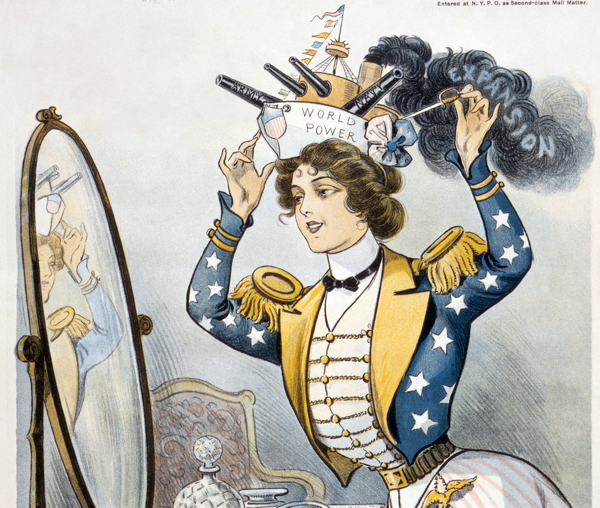
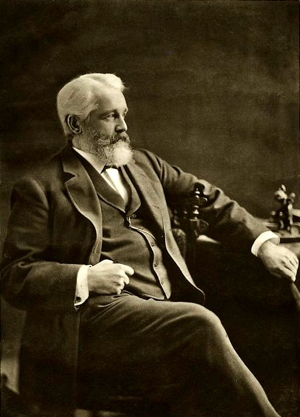

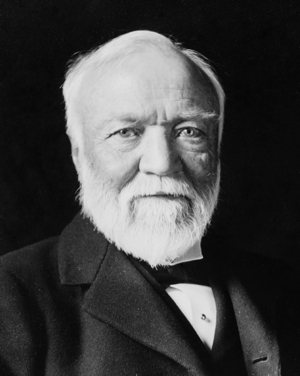

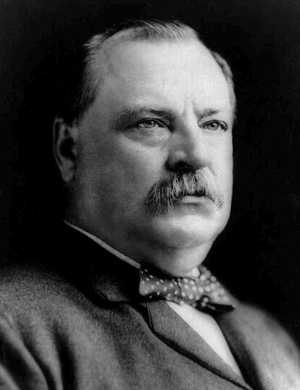
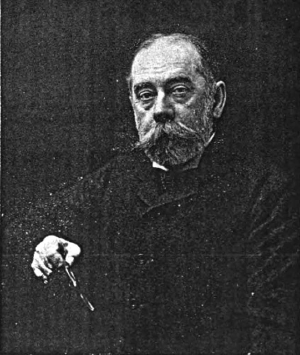
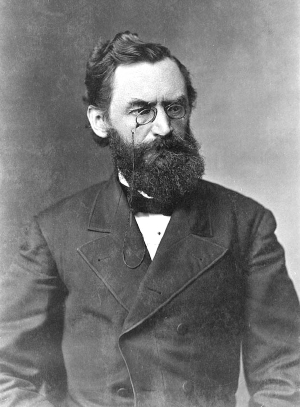
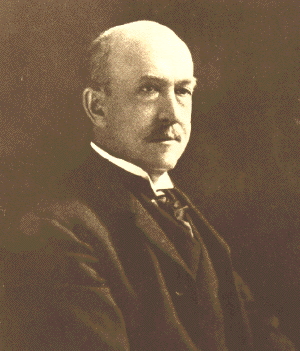
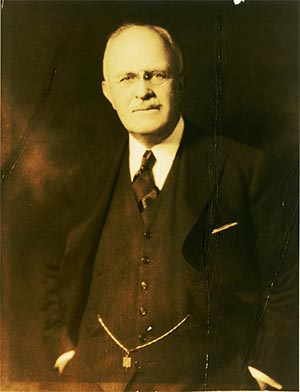
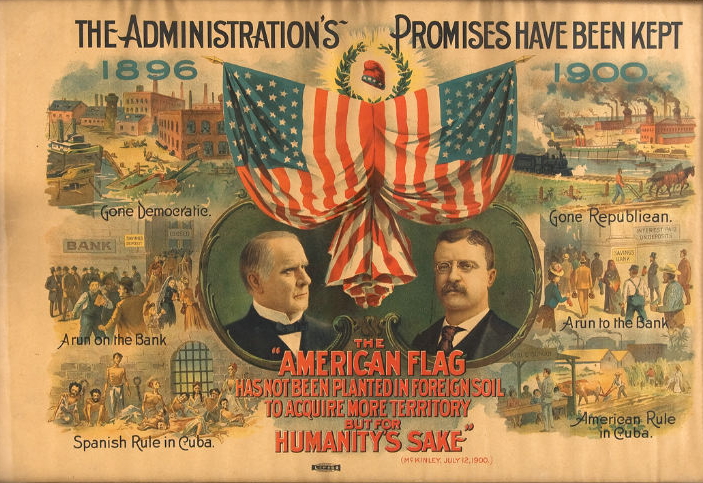

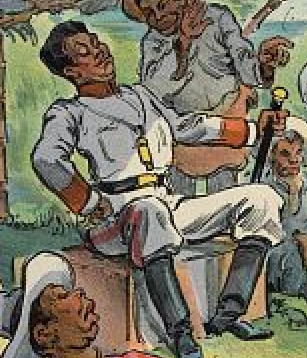
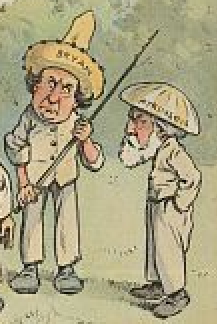
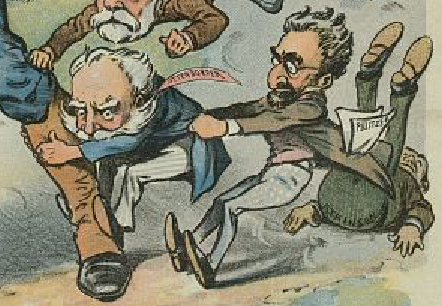
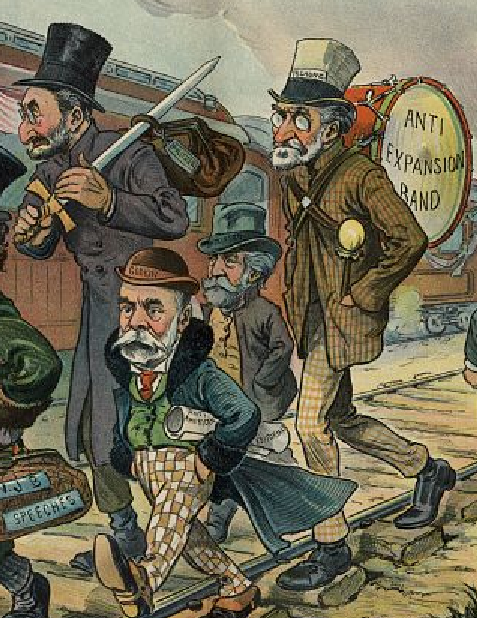
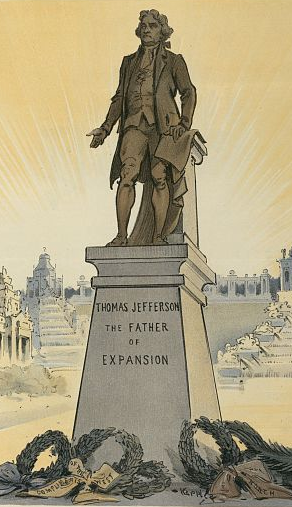
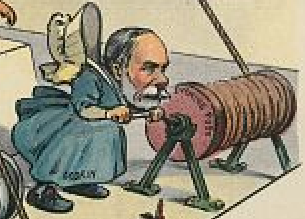

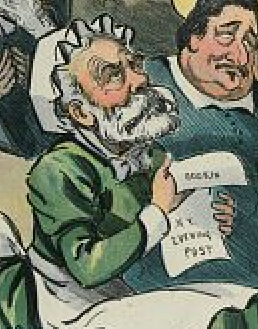
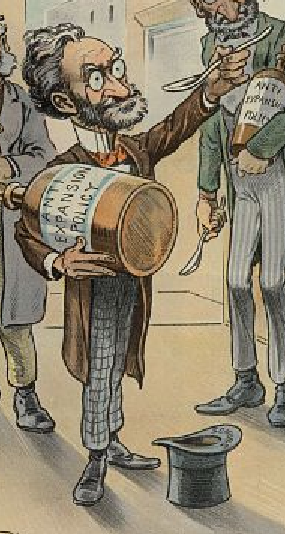

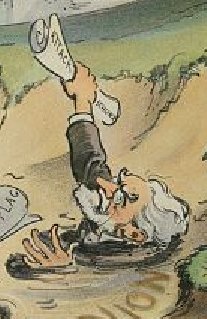
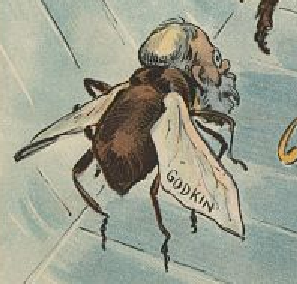

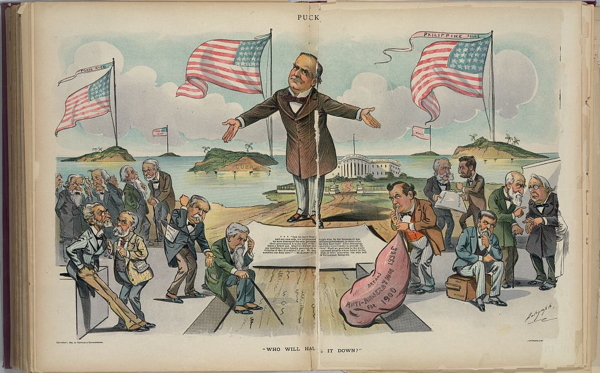
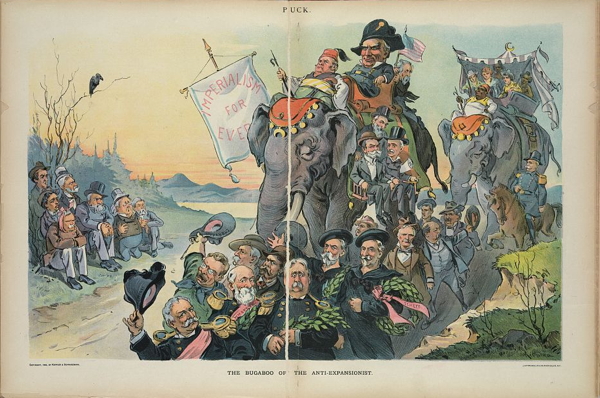
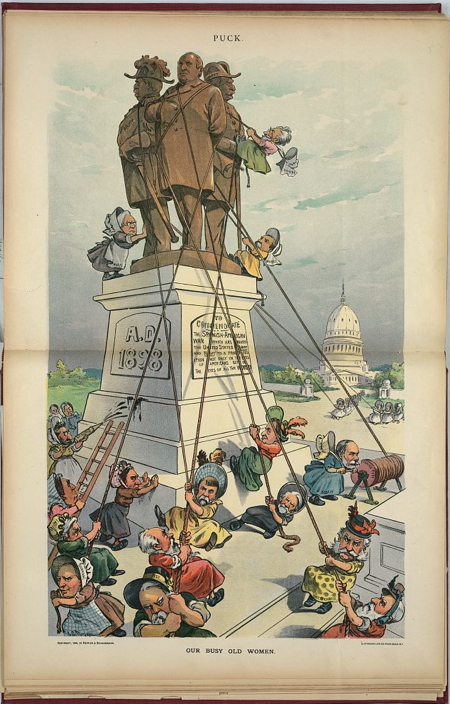



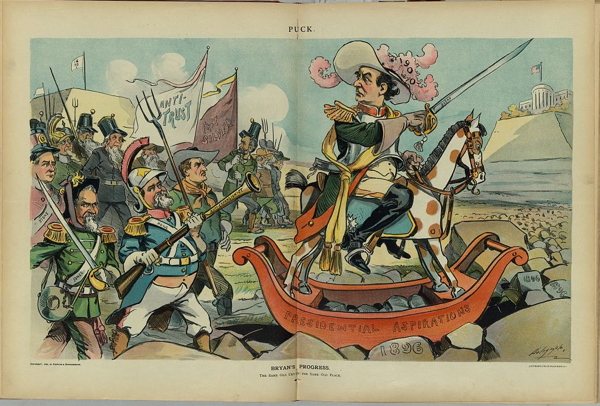

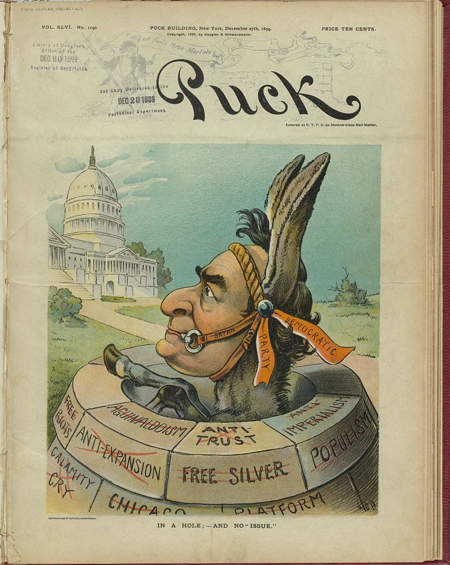
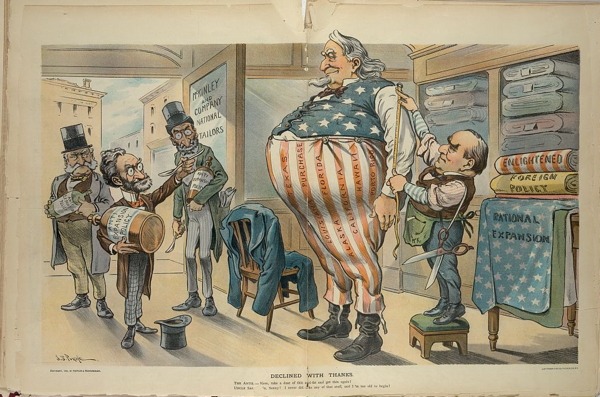


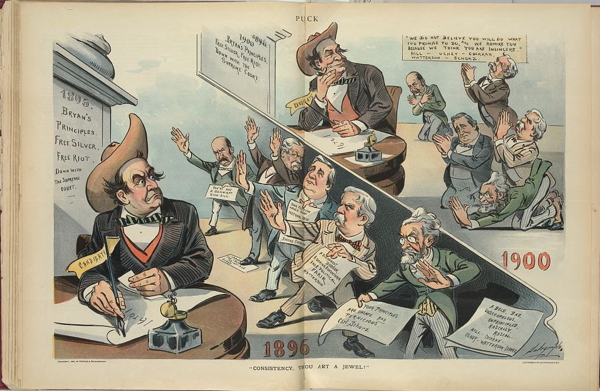
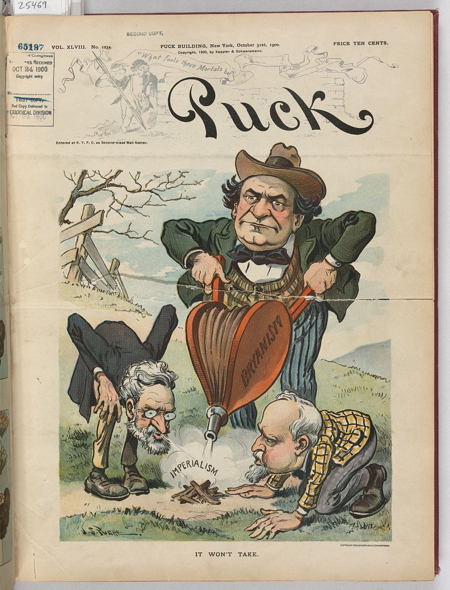
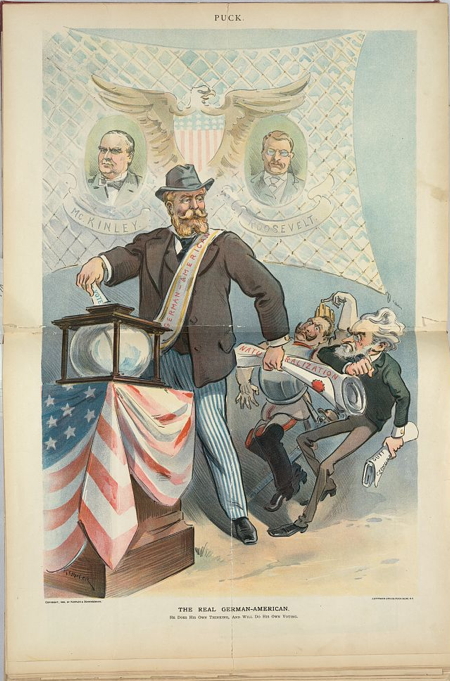
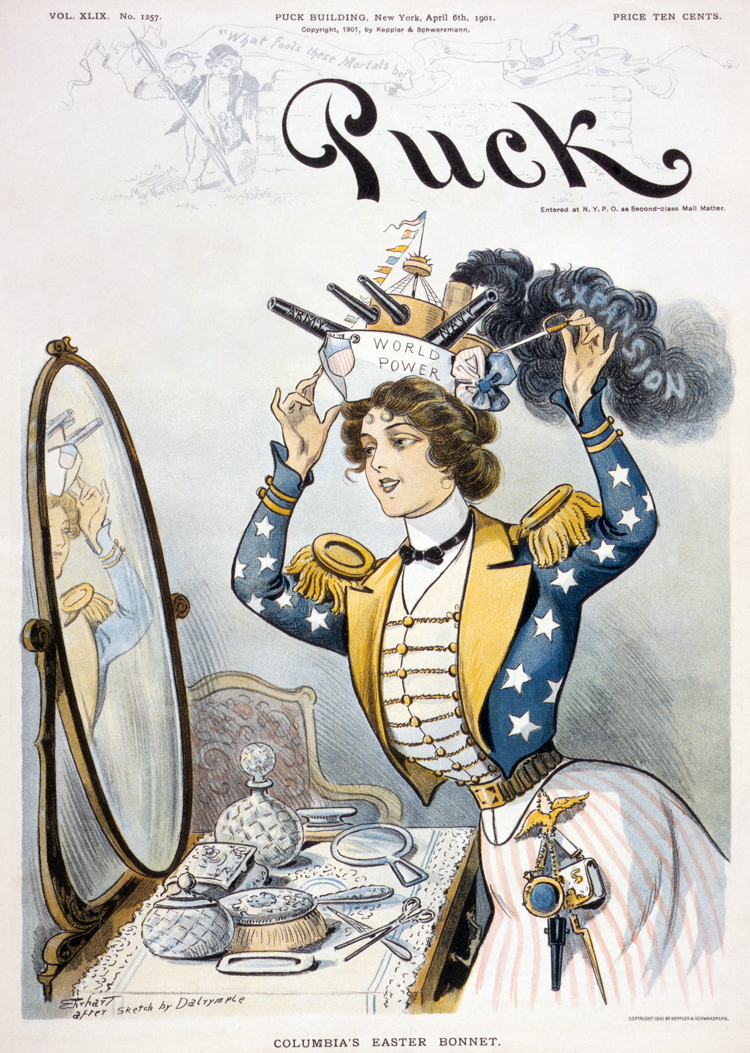
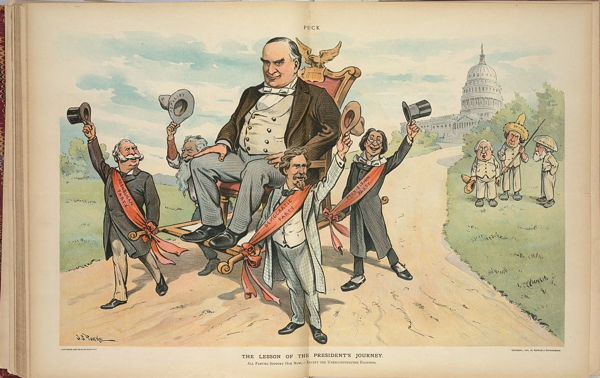
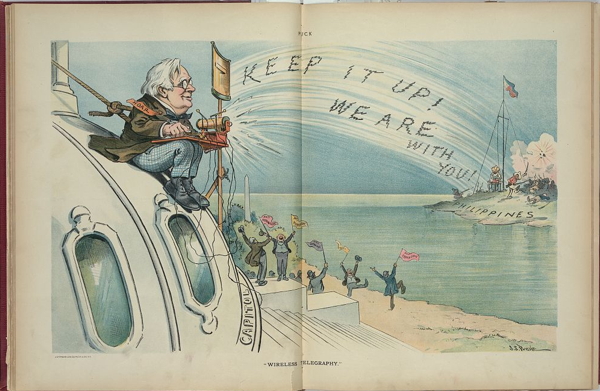
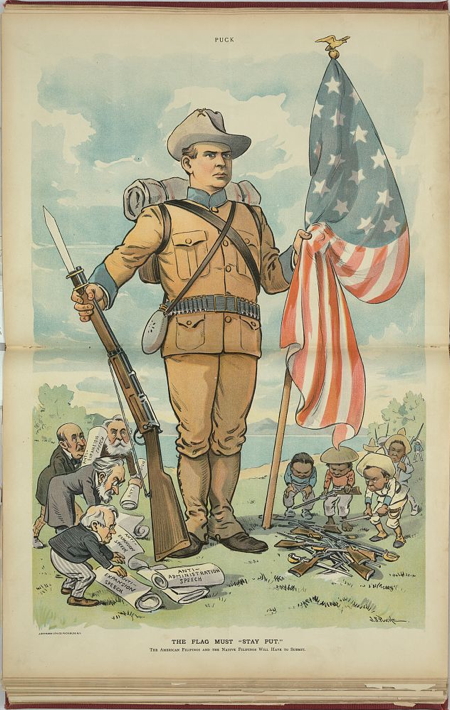
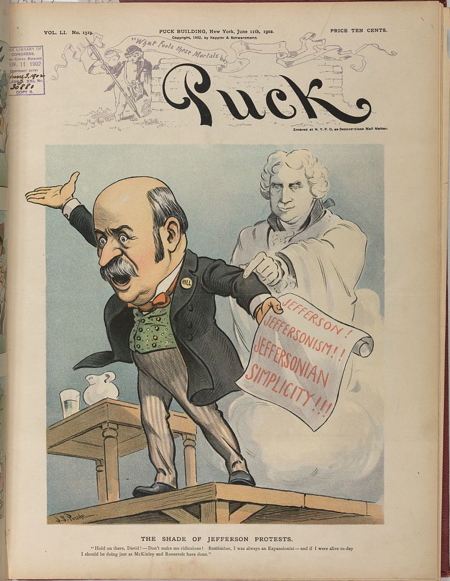
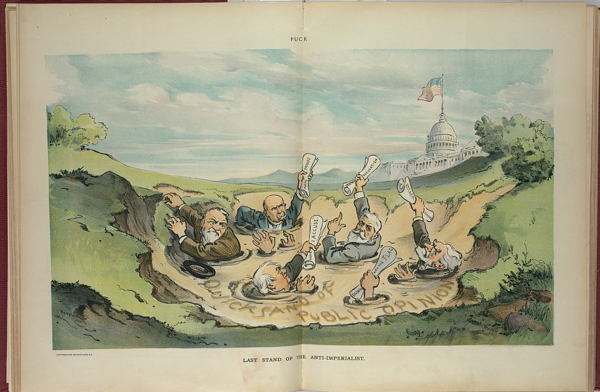
















































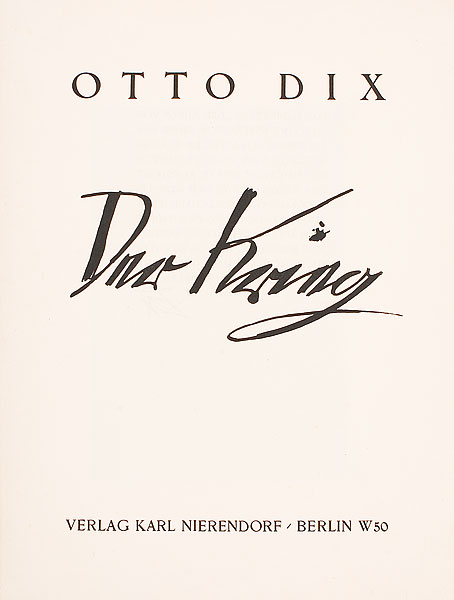
Here is a selection of 14 of the 50 drawings which the German artist Otto Dix (1891–1969) published in 1924. See the complete collection of drawings here (with different sizes for each image). See also my Study Guide on Otto Dix for a discussion of this and some other works of art.
Source: Otto Dix, Der Krieg (The War) (Berlin: Otto Felsing, Karl Nierendorf, 1924). The are 50 drawings with 10 Mappe (Portfolios) with 10 drawings in each.
Image source: National Gallery of Australia <http://nga.gov.au/Home/Default.cfm>. Otto Dix Collection .
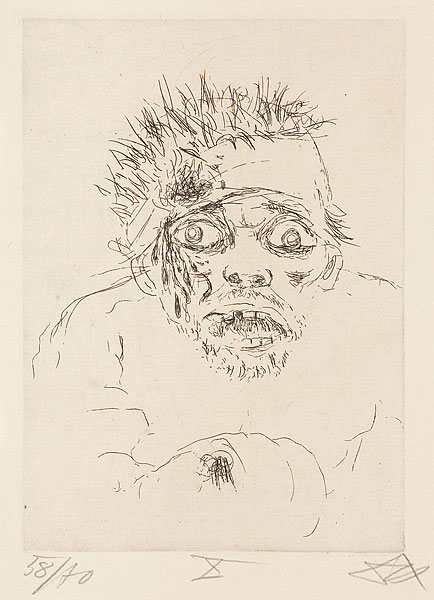
2. Wounded Man Fleeing (Battle of the Somme, 1916) [Fliehender Verwundeter (Sommeschlacht 1916)]

3. Abandoned Position near Neuville (Verlassene Stellung bei Neuville)
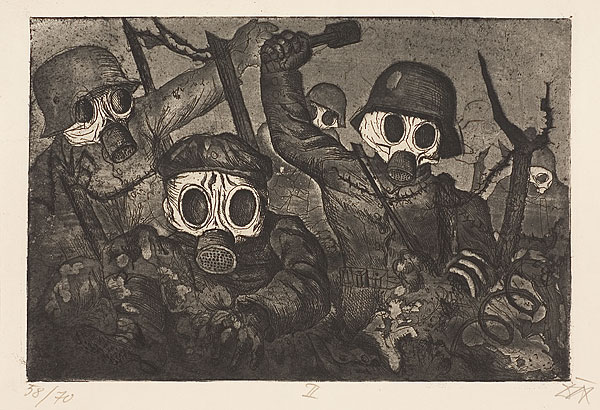
4. Shock Troops Advance under Gas (Sturmtruppe geht unter Gas vor)
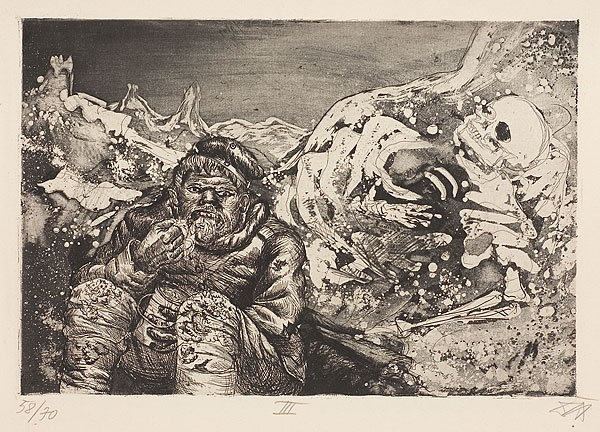
5. Mealtime in the Trench (Loretto Heights) [Mahlzeit in der Sappe (Lorettohöhe)]
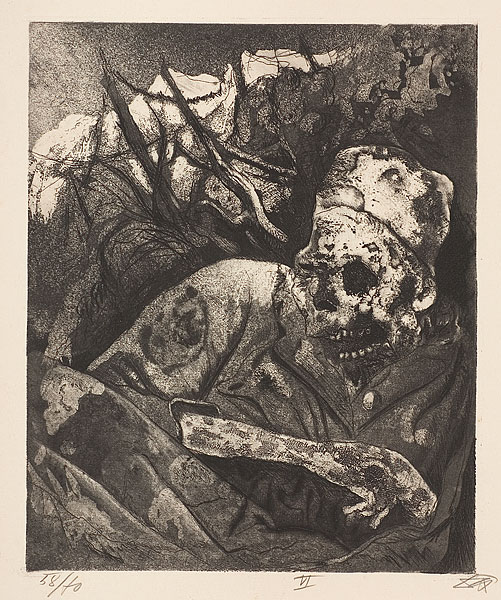
8. Corpse in Barbed Wire (Flanders) [Leiche im Drahtverhau (Flandern)]
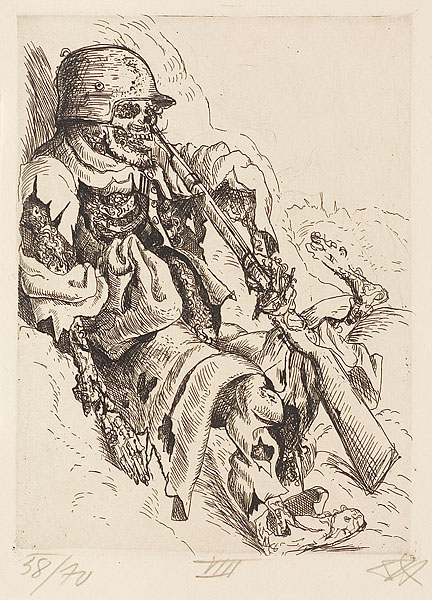
10. Dead Sentry in the Trench (Toter Sappenposten)
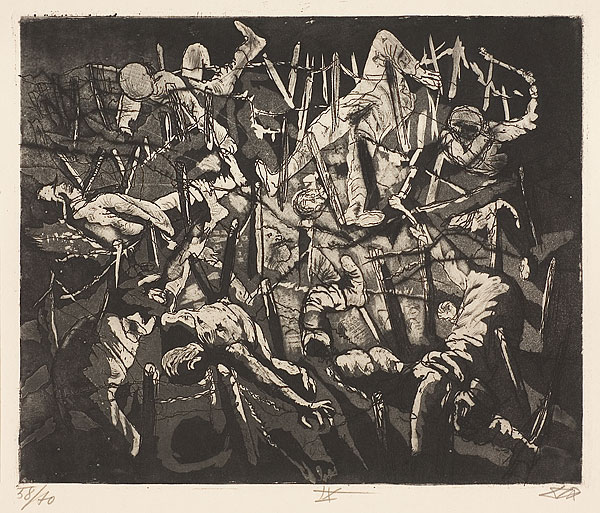
11. Dance of Death 1917 (Dead Man Heights) [Totentanz anno 17 (Höhe Toter Mann)]
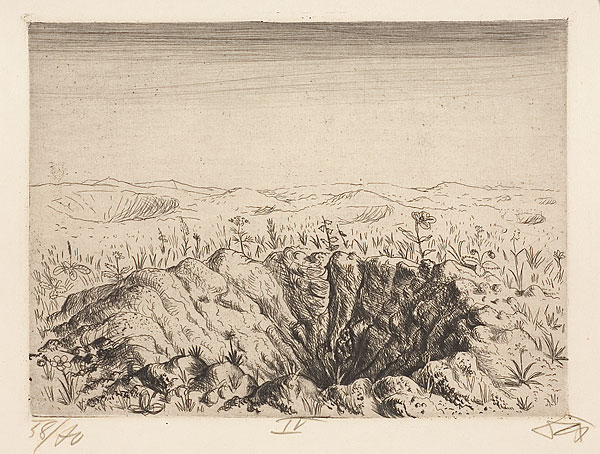
17. Shell Crater with Flowers (Spring 1916) [Granattrichter mit Blumen (Frühling 1916)]
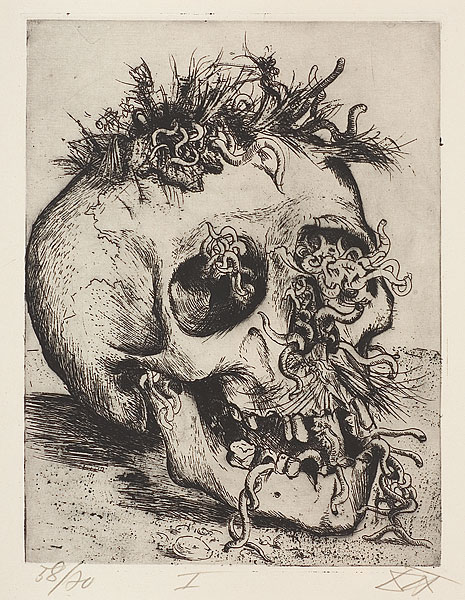
25. Skull (Schädel)
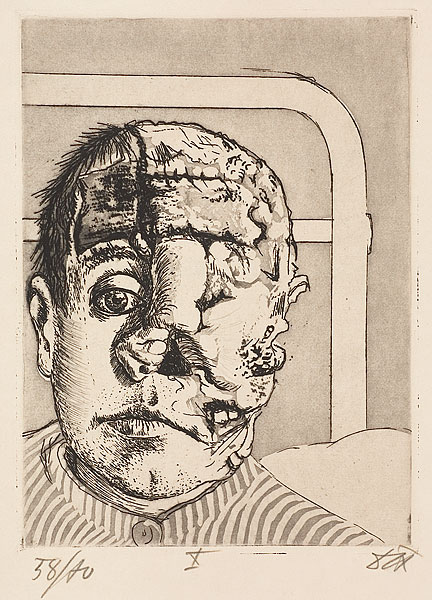
35. Skin Graft (Transplantation)
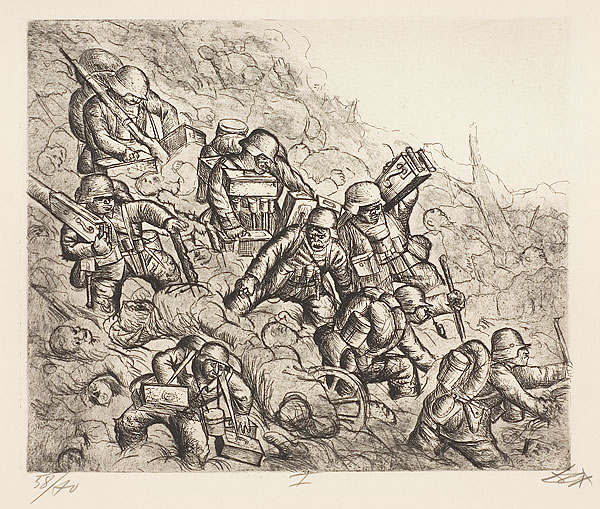
36. Machine-Gun Squad Advances (Somme, November 1916) [Maschinengewehrzug geht vor (Somme, November 1916)]
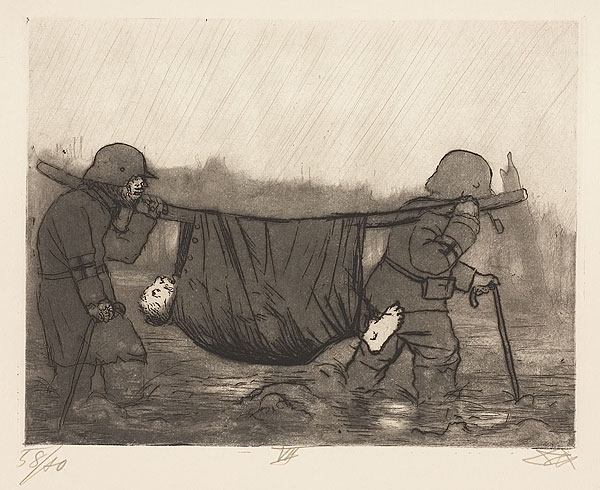
42. Transporting the Wounded in Houthulst Forest (Verwundetentransport im Houthulster Wald)

44. Horse Cadaver (Pferdekadaver)
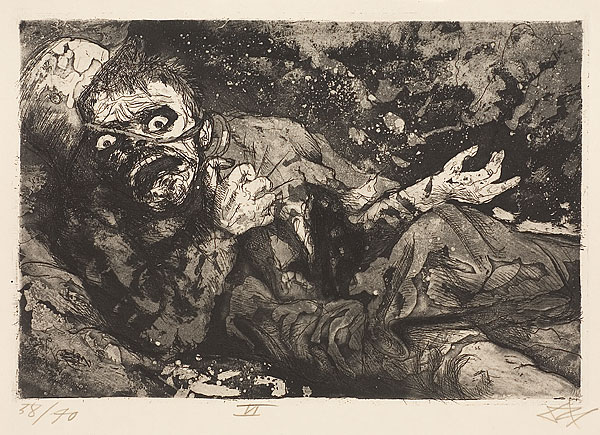
46. Wounded Man (Autumn 1916, Bapaume) [Verwundeter (Herbst 1916, Bapaume)].
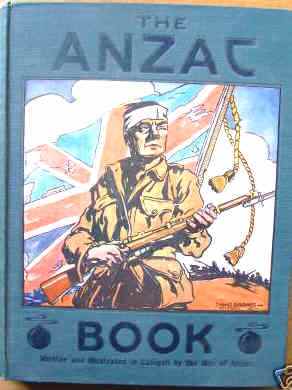
The Anzac Book. Written and Illustrated in Gallipoli by The Men of Anzac. For the benefit of Patriotic Funds connected with the A.& N.Z.A.C. (London, New York, Toronto and Melbourne, 1916). Introduction by Sir W.R. Birdwood, pp. ix-x (ANZAC December 19, 1915). "Editor's Note" by The ANZAC Book Staff (Aegean Sea, December 29, 1915).
"An ANZAC Alphabet" by Henderson is one of the best loved illustrations in the ANZAC Book (pp. 115-18). It is a 4 page rhyming poem based upon the letters of the alphabet with rather crude illustrations of each letter of the alphabet along with a two line poem which illustrates various aspects of the soldiers' life at Gallipoli. This was not the only ANZAC alphabet which appeared in the ANZAC Book A second one "Another Attempt at an ANZAC Alphabet" (by "Ubique" [Latin for "everywhere"]) appeared a few pages later (pp. 146-47) but it was not illustrated and is less well known. It takes a roughly chronological approach to relating his experiences at Gallipoli and focuses more on the everyday hardships and fear faced by the soldiers.
I will display the Alphabets in three separate posts: a general overview of both; and a separate one for each of the Alphabets. The Henderson Alphabet will contain many images - of each page in the ANZAC Book and then the individual letters of the alphabet.
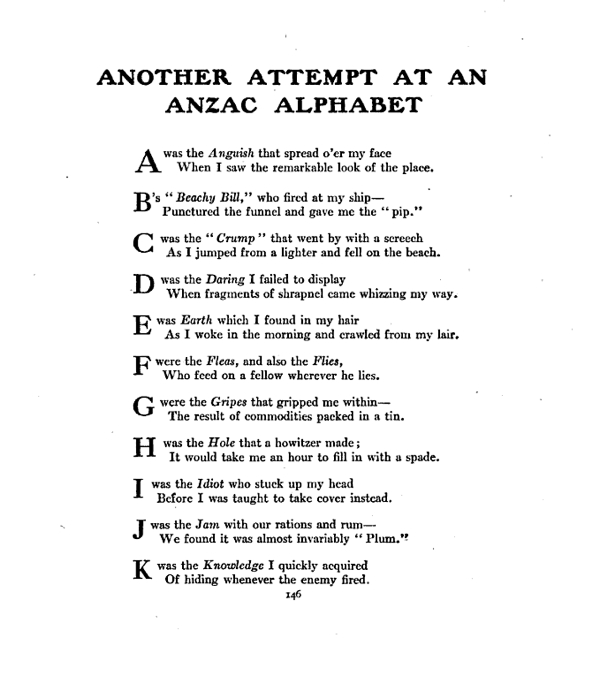
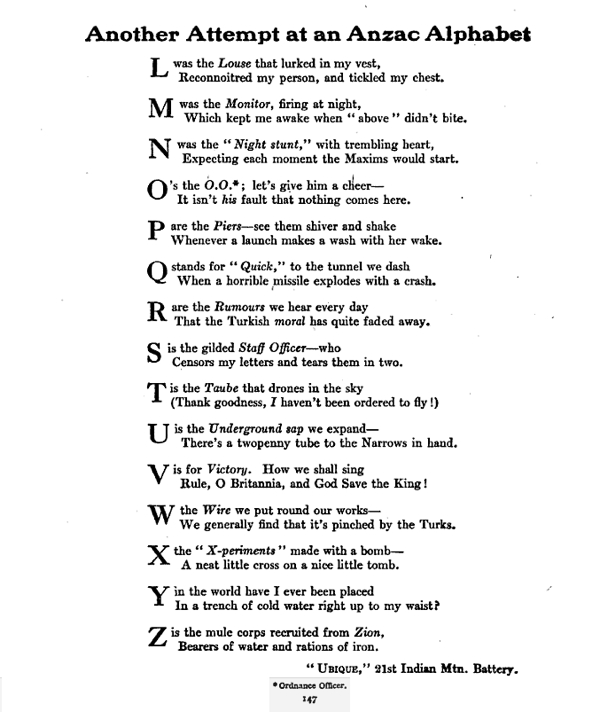

The Anzac Book. Written and Illustrated in Gallipoli by The Men of Anzac. For the benefit of Patriotic Funds connected with the A.& N.Z.A.C. (London, New York, Toronto and Melbourne, 1916). Introduction by Sir W.R. Birdwood, pp. ix-x (ANZAC December 19, 1915). "Editor's Note" by The ANZAC Book Staff (Aegean Sea, December 29, 1915).
"An ANZAC Alphabet" by Henderson is one of the best loved illustrations in the ANZAC Book (pp. 115-18). It is a 4 page rhyming poem based upon the letters of the alphabet with rather crude illustrations of each letter of the alphabet along with a two line poem which illustrates various aspects of the soldiers' life at Gallipoli. This was not the only ANZAC alphabet which appeared in the ANZAC Book A second one "Another Attempt at an ANZAC Alphabet" (by "Ubique" [Latin for "everywhere"]) appeared a few pages later (pp. 146-47) but it was not illustrated and is less well known. It takes a roughly chronological approach to relating his experiences at Gallipoli and focuses more on the everyday hardships and fear faced by the soldiers.
I will display the Alphabets in three separate posts: a general overview of both; and a separate one for each of the Alphabets. The Henderson Alphabet will contain many images - of each page in the ANZAC Book and then the individual letters of the alphabet.
The Henderson ANZAC Alphabet: An ANZAC Alphabet, by J.W.S. Henderson, R.G.A. [pp. 115-18].
First I will show images of the pages as they appeared in the original book, then images of the individual letters and their accompanying poem. Please see the previous post for a text only version of the poem.
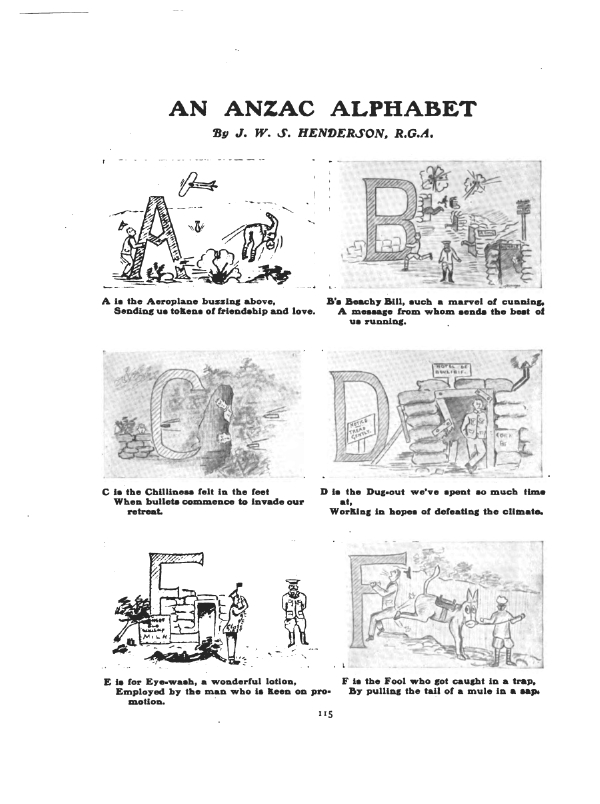

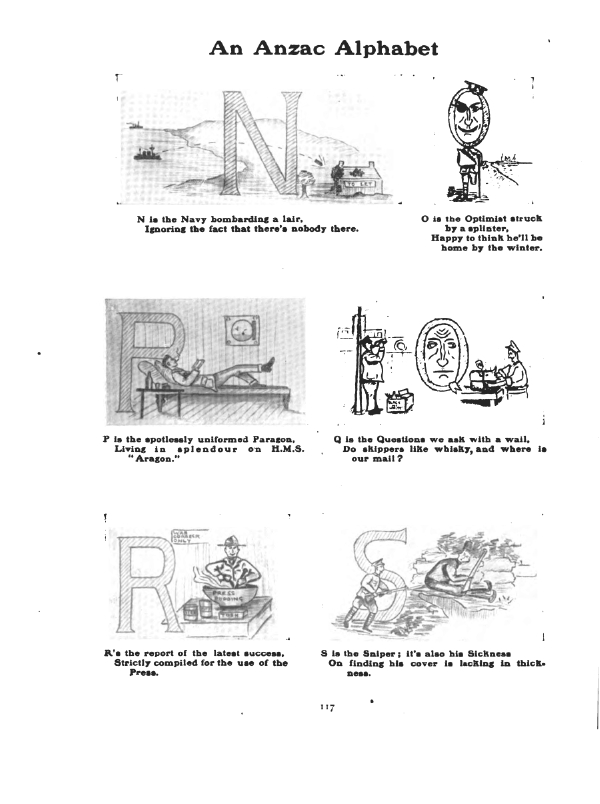
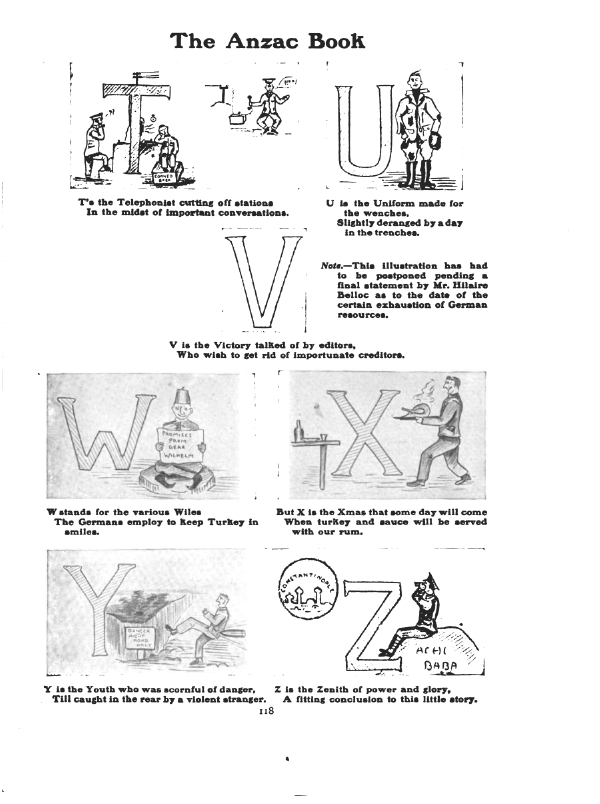



























The Anzac Book. Written and Illustrated in Gallipoli by The Men of Anzac. For the benefit of Patriotic Funds connected with the A.& N.Z.A.C. (London, New York, Toronto and Melbourne, 1916). Introduction by Sir W.R. Birdwood, pp. ix-x (ANZAC December 19, 1915). "Editor's Note" by The ANZAC Book Staff (Aegean Sea, December 29, 1915).
"An ANZAC Alphabet" by Henderson is one of the best loved illustrations in the ANZAC Book (pp. 115-18). It is a 4 page rhyming poem based upon the letters of the alphabet with rather crude illustrations of each letter of the alphabet along with a two line poem which illustrates various aspects of the soldiers' life at Gallipoli. This was not the only ANZAC alphabet which appeared in the ANZAC Book A second one "Another Attempt at an ANZAC Alphabet" (by "Ubique" [Latin for "everywhere"]) appeared a few pages later (pp. 146-47) but it was not illustrated and is less well known. It takes a roughly chronological approach to relating his experiences at Gallipoli and focuses more on the everyday hardships and fear faced by the soldiers.
I will display the Alphabets in three separate posts: a general overview of both; and a separate one for each of the Alphabets. The Henderson Alphabet will contain many images - of each page in the ANZAC Book and then the individual letters of the alphabet.
An ANZAC Alphabet, by J.W.S. Henderson, R.G.A. [pp. 115-18].
A is the Aeroplane buzzing above,
Sending us tokens of friendship and love.
B's Beachy Bill, such a marvel of cunning,
A message from whom sends the best of us running.
C is the Chilliness felt in the feet
When bullets commence to invade our retreat.
D is the Dug-out we've spent so much time at,
Working in hopes of defeating the climate.
E is for Eye-wash, a wonderful lotion,
Employed by the man who is keen on promotion.
F is the Fool who got caught in a trap,
By pulling the tail of a mule in a sap.
G is the General devising a strafe,
And cursing his highly incompetent staff.
H is the wretched unfortunate Hill,
Bombarded and mined but impregnable still.
I's the Intelligence officer who
Is said to exist at G.H.Q.
Forgive a digression and spare me the time
To think of a word that will make a good rhyme,
And if the delay is a little provoking,
Remember it's J and the word may be Joking.
K is the Kaiser at home in Berlin,
Chanting his quaint maledictory hymn.
L is the Liar who loves to relate
Achi Baha has fallen, and gives you the date.
M is the Major observing from latitudes
Tending to strained and discomforting attitudes.
N is the Navy bombarding a lair,
Ignoring the fact that there's nobody there.
O is the Optimist struck by a splinter,
Happy to think he'll be home by the winter.
P is the spotlessly uniformed Paragon,
Living in splendour on H.M.S. "Aragon."
Q is the Questions we ask with a wail,
Do skippers like whisky, and where is our mail?
R’s the report of the latest success,
Strictly compiled for the use of the Press.
S is the Sniper; it's also his Sickness
On finding his cover is lacking in thickness.
T’s the Telephonist cutting off stations
In the midst of important conversations.
U is the Uniform made for the wenches,
Slightly deranged by a day in the trenches.
V is the Victory talked of by editors,
Who wish to get rid of importunate creditors.
Note.—This illustration has had to be postponed pending a final statement by Mr. Hilaire Belloc as to the date of the
certain exhaustion of German resources.
W stands for the various Wiles
The Germans employ to keep Turkey in smiles.
But X is the Xmas that some day will come
When turkey and sauce will be served with our rum.
Y is the Youth who was scornful of danger,
Till caught in the rear by a violent stranger.
Z is the Zenith of power and glory,
A fitting conclusion to this little story.
Another Attempt at an ANZAC Alphabet (by "Ubique," 21st Indian Mtn. Battery) [pp. 146-47].
A was the Anguish that spread o'er my face
When I saw the remarkable look of the place.
B's "Beachy Bill," who fired at my ship -
Punctured the funnel and gave me the "pip."
C was the"Crump" that went by with a screech
As I jumped from a lighter and fell on the beach.
D was the Daring I failed to display
When fragments of shrapnel came whizzing my way.
E was the Earth which I found in my hair
As I woke in the morning and crawled from my lair.
F were the Fleas, and also the Flies,
Who feed on a fellow wherever he lies.
G were the gripes that gripped me within -
The result of commodities packed in a tin.
H was the Hole that a howitzer made;
It would take me an hour to fill in with a spade.
I was the Idiot who stuck up my head
Before I was taught to take cover instead.
J was the Jam with our rations and rum -
We found it was almost invariably "Plum."
K was the Knowledge I quickly acquired
Of hiding whenever the enemy fired.
L was the Louse that lurked in my vest,
Reconnoitred my peson and tickled my chest.
M was the Monitor, firing at night,
Which kept me awake when “above” didn’t bite.
N was the “Night stunt,” with trembling heart,
Expecting each moment the Maxims would start.
O’s the 0.0. (Ordnance Officer); let’s give him a cheer—
It isn’t his fault that nothing comes here.
P are the Piers—see them shiver and shake
Whenever a launch makes a wash with her wake.
Q stands for “Quick,” to the tunnel we dash
When a horrible missile explodes with a crash.
R are the Rumours we hear every day
That the Turkish moral has quite faded away.
S is the gilded Staff Officer—who
Censors my letters and tears them in two.
T is the Taube that drones in the sky
(Thank goodness, I haven’t been ordered to fly!)
U is the Underground sap we expand—
There’s a twopenny tube to the Narrows in hand.
V is for Victory. How we shall sing
Rule, O Britannia, and God Save the King!
W the Wire we put round our works-
We generally find that it’s pinched by the Turks.
X the “X-periments” made with a bomb—
A neat little cross on a nice little tomb.
Y in the world have I ever been placed
In a trench of cold water right up to my waist?
Z is the mule corps recruited from Zion,
Bearers of water and rations of iron.
"Ubique," 21st Indian Mtn. Battery.

The Anzac Book. Written and Illustrated in Gallipoli by The Men of Anzac. For the benefit of Patriotic Funds connected with the A.& N.Z.A.C. (London, New York, Toronto and Melbourne, 1916). Introduction by Sir W.R. Birdwood, pp. ix-x (ANZAC December 19, 1915). "Editor's Note" by The ANZAC Book Staff (Aegean Sea, December 29, 1915).

[Below are some other covers of ANZAC magazines from the period which are quite patriotic and optimistic as one would expect.]
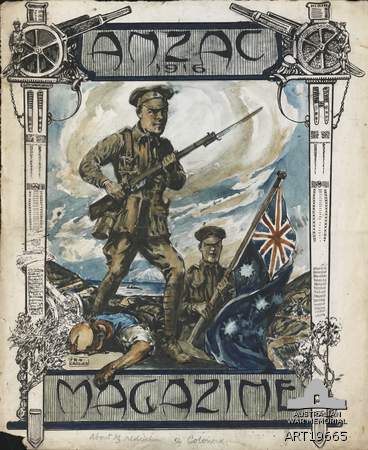

This is a famous book created by some of the Australian and New Zealand soldiers who landed at Gallipoli [now Gelibolu] in Turkey on 25 April 1915. It was part of a British and French attempt to knock the Ottoman Empire (allied with Germany and Austria) out of the war and to relieve the Russian Empire fighting on the eastern front. It failed to achieve these objectives and the soldiers were withdrawn by 9 January, 1916. The invading forces had 44,092 men killed and the defending Turks lost 86,692 men killed. Of these deaths, the ANZAC forces lost 11,430 men killed (Australia 8,709 and NZ 2,721). Given the very low population of both the countries the death toll was seen as quite heavy.
The book was compiled in late November in order explicitly to raise money for the war effort but with the additional, unstated goal of telling the world about how the ANZACs had coped in battle. It contains material by both officers and men, including C.E.W. Bean who is listed as one of the editors. He later went on to write a famous official history of Australian involvement in WW1 and helped establish the "ANZAC myth" in Australian history. Some of the material expresses frustration and even anger at some of the things that the enlisted men had to endure but this is rather muffled as I'm sure military censorship would have been very much in the back of their minds, as well as a fear of "letting down" their families back home. Publication was delayed because while the book was being edited the troops learned of plans to withdraw them early in the new year. This, in some respects the ANZAC Book became a farewell from the troops after enduring 9 months of fruitless combat.
The version of the book I got from Google also contains 2 other separate books of NZ material of a very similar nature. They are dated 1917 and 1918. If I make time I will post them online as well as they are most interesting. There are many images of Kiwis and a few Koalas which is how the artists distinguished between the 2 groups of soldiers.
This brief essay will be in two parts. The first will show the complete set of the 8 coloured plates which were used in the 200 page book. The second part will contain a selection of the other black and white cartoons and illustrations which provide some insight into the minds of the men who were present at Gallipoli in 1915. I will also include the quite famous drawings of the "ANZAC Alphabet".
Here are a couple of interesting illustrations which i suggest are trying to tell us another story about the ANZAC experience in the face of the military censors who no doubt would tolerate humour and some mild criticism but nothing stronger than that. At the end of the "Editor's Note" (perhaps which many would not read very closely) there is a pair of illustrations which suggest that reality was quite different from the ideal view of sacrifice and combat which the troops would have learned at school and basic training. A common image throughout the work is that of the soldiers as mere beasts of burden or "donkeys" The second image appears at the very beginning of the book and shows a fairly cheeky soldier with a cigarette on his lips, looking a bit angry, and carrying a bandaged eye. The slogan is not "Season's Greetings" which one might have expected in a book published at Christmas time in 1915 but a more confrontational "Complaints of the Season." A third piece of evidence is the cover of the book, an image of which can be found at the top of this post. Here we see a very battered but determined looking digger with a bandaged head, standing before a bullet-ridden Union Jack (the Aussies did not have their own flag at this time). The army of the Empire had taken a beating at Gallipoli and the picture shows it.

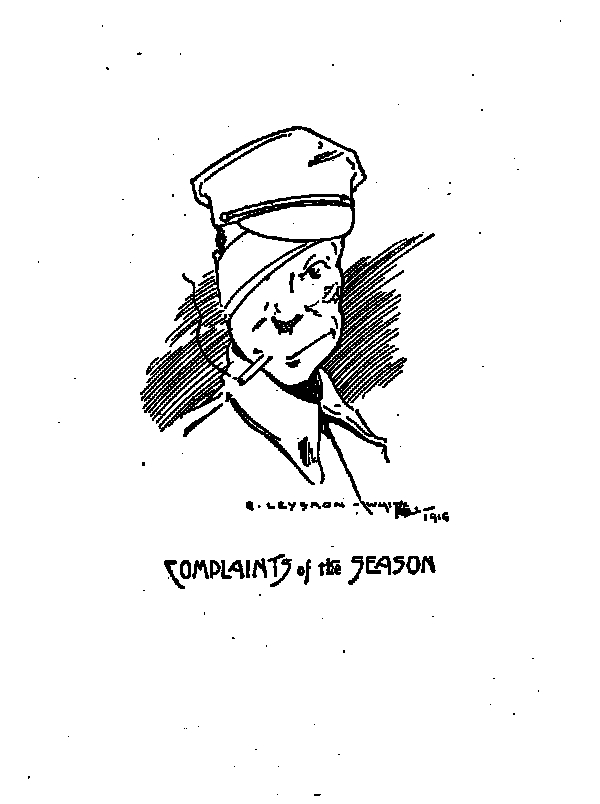
What follows below are a set set of the 8 colored plates from the book:
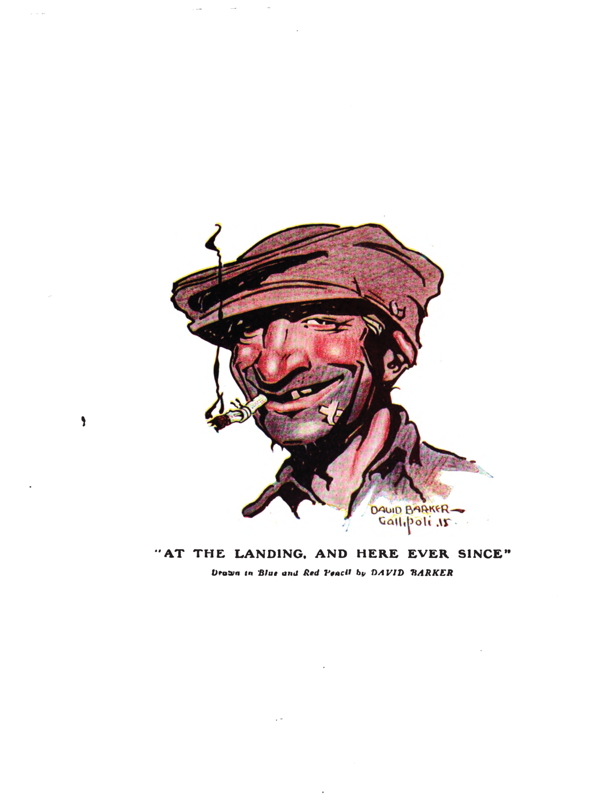
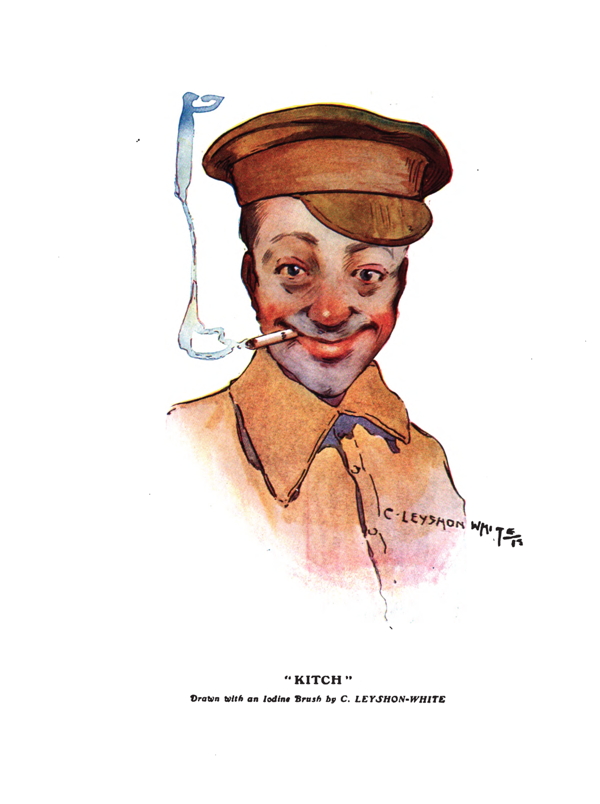

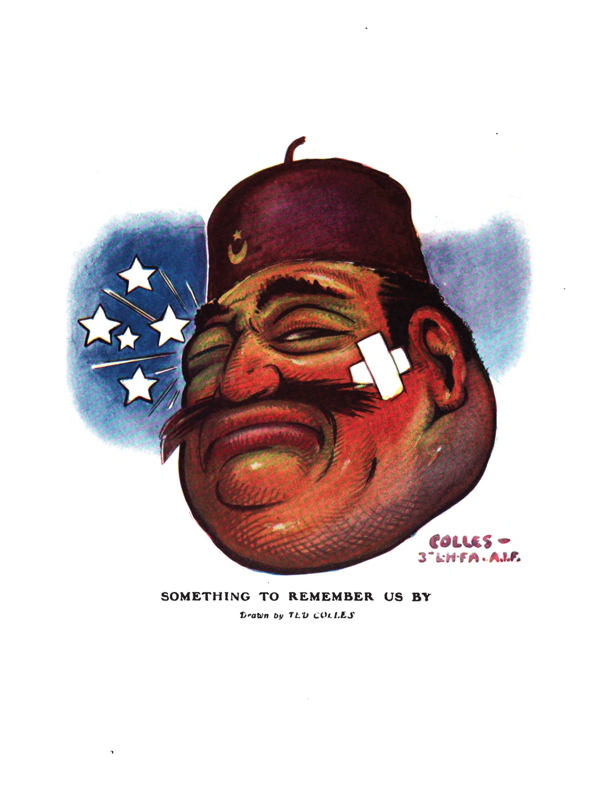
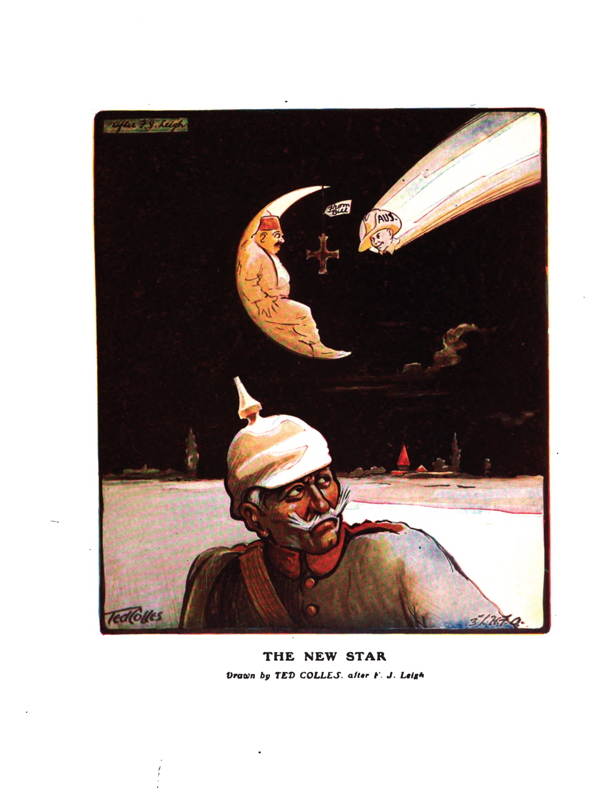
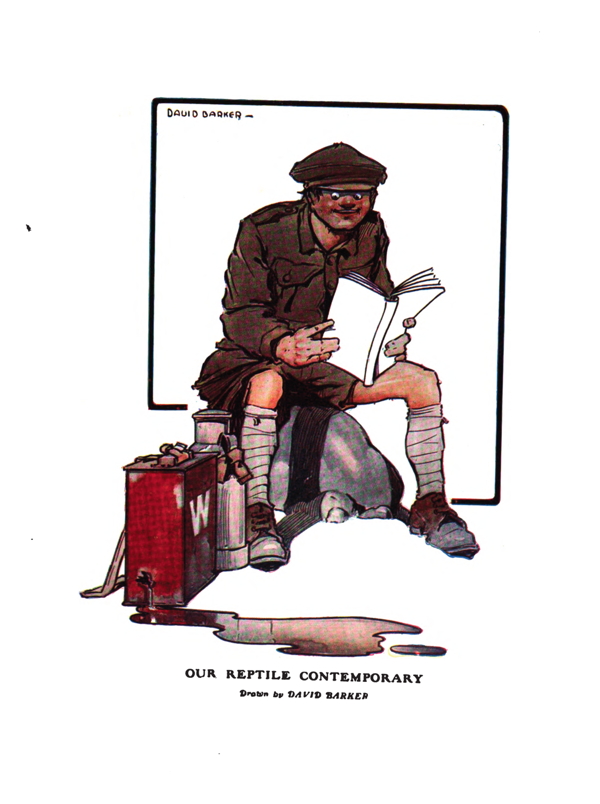
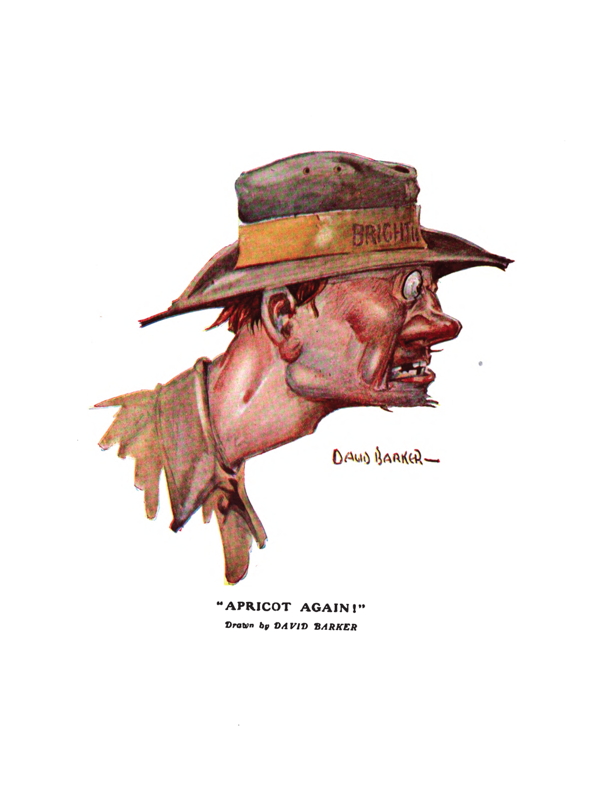
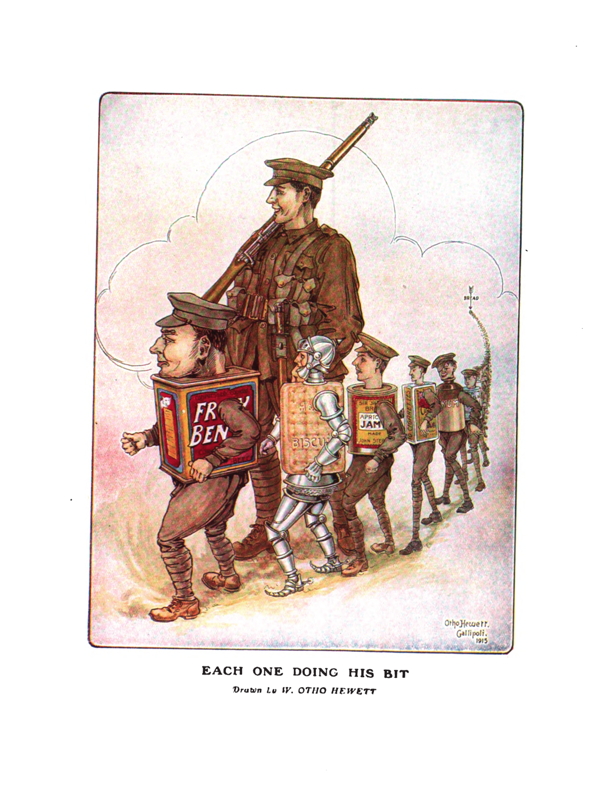



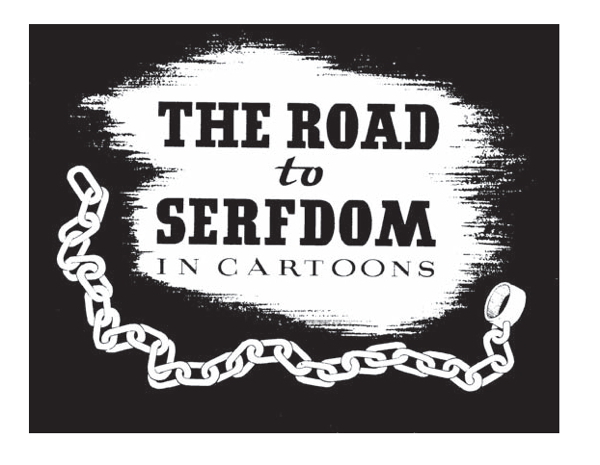
As a companion piece to FEE's condensed and illustrated version of Bastiat's The Law (1850, late 1940s) here is a condensed and illustrated version of Friedrich Hayek's The Road to Serfdom (1944). This is what Wikipedia has to say about this version: "A condensed version of the book written by Max Eastman was then published as the lead article in the April 1945 issue of Reader's Digest, with a press run of several million copies. This condensed version was then offered as a Book of the Month selection with a press run of over 600,000 copies. In February 1945 a picture-book version was published in Look magazine, later made into a pamphlet and distributed by General Motors." [Since General Motors has been the recipient of a massive government bailout by the Obama administration I'm not sure they would support Hayek's or Bastiat's views about the free market today and would probably disavow their affiliation with this edition today.]
The Institute for Economic Affairs in London produced a very nice edition which combines this and other versions into one book: Friedrich A. Hayek, The Road to Serfdom with The Intellectuals and Socialism. The Condensed Version of The Road to Serfdom by F.A. Hayek as it appeared in the April 1945 edition of Reader's Digest (London: The Institute for Economic Affairs, 2005).
As you can see from the illustrations the depiction of the "planners" draws from the historical example of the Nazi Party (arm bands and jack boots). If the illustrated version sere to be updated to the present the artist would no doubt draw the "planners" in business suits which is the uniform worn by the current generation of planners and regulators. The politicians and bureaucrats of today think that if they wear the uniform of the businessman and not the Gauleiter we won't notice the difference. Another major difference is the concluding illustration. In 1944-45 it might have seemed that the inevitable result of government planning of the economy would be the firing squad for any dissenters or rebels. We now know that this is rather overwrought. After 70 years of government planning, inflation, and growing debt we know that this is not necessary for the state to maintain its rule. The old Roman strategy of "bread and circuses" for the masses seems to work every time. We can and have been bought off repeatedly. The "serfdom" of the modern welfare/warfare state is a much softer kind of serfdom to that which existed under Nazism and Stalinism.
Here are the illustrations:
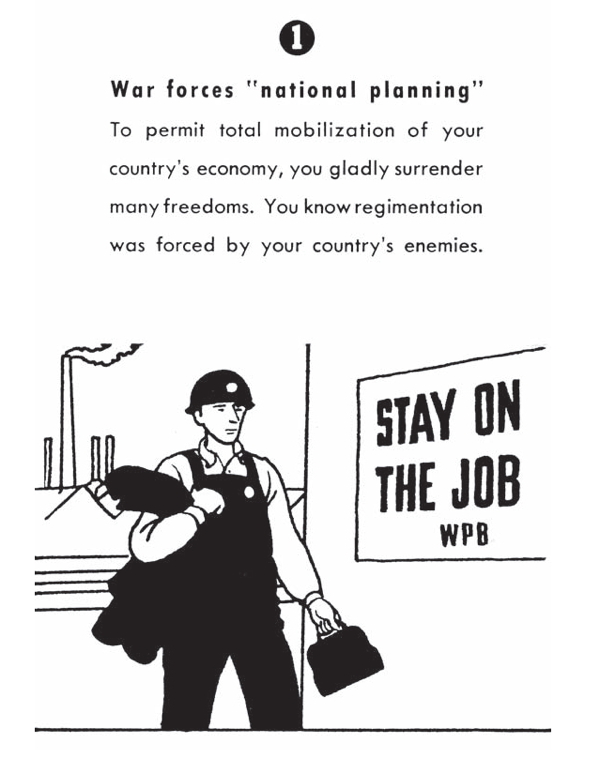


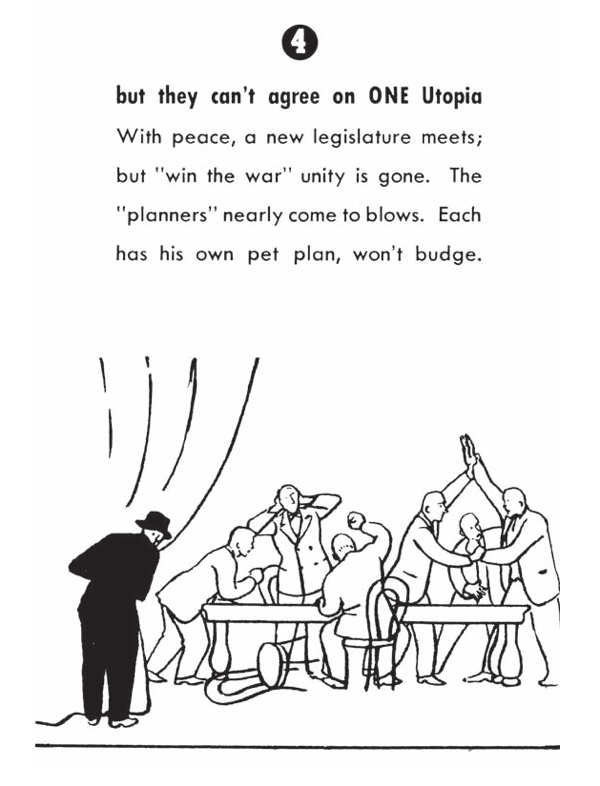
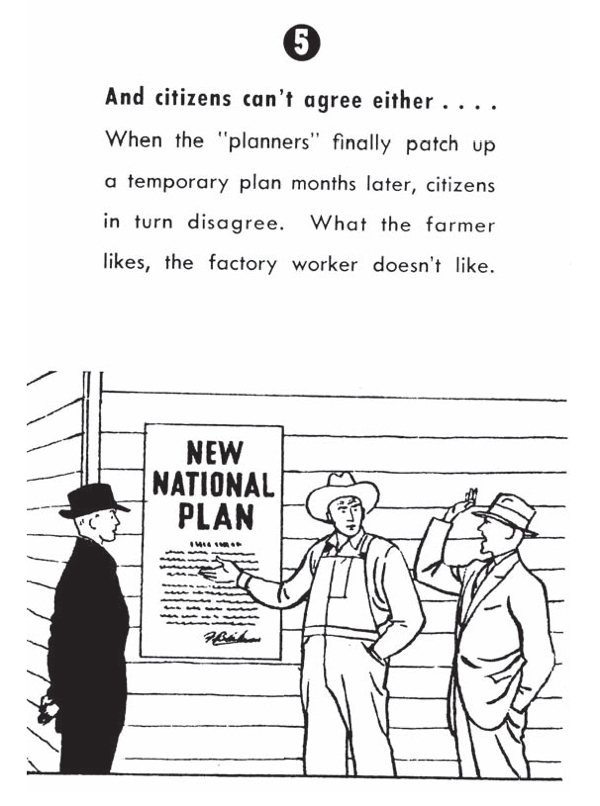
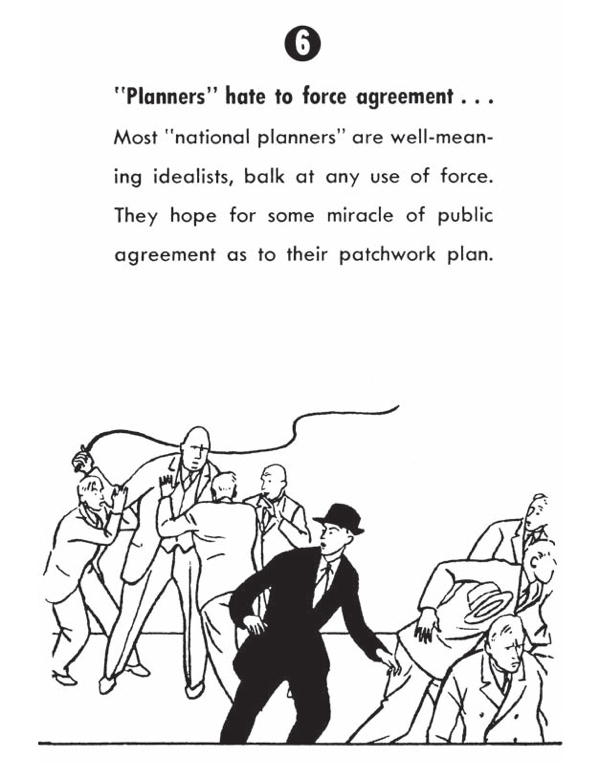
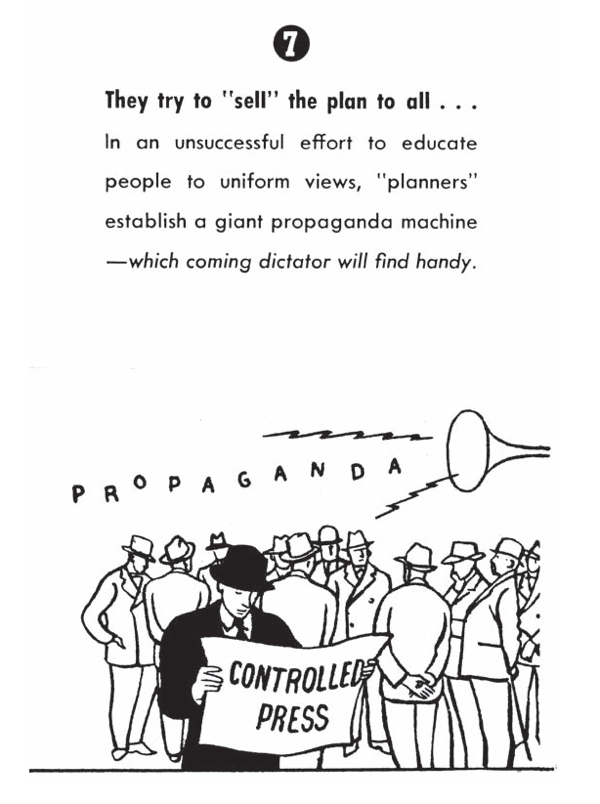
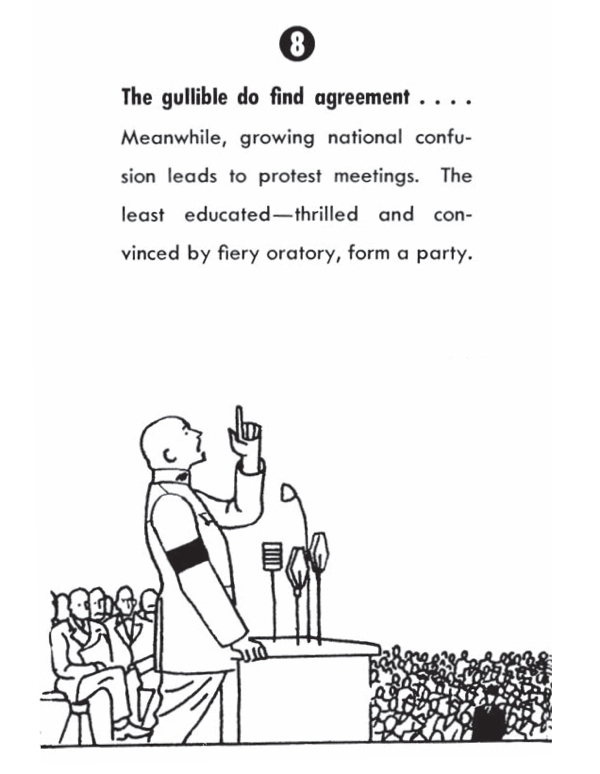
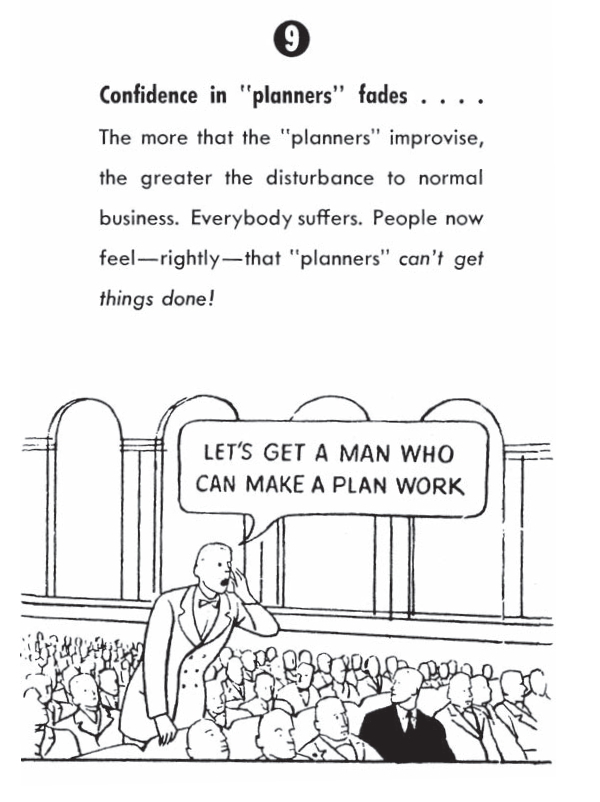
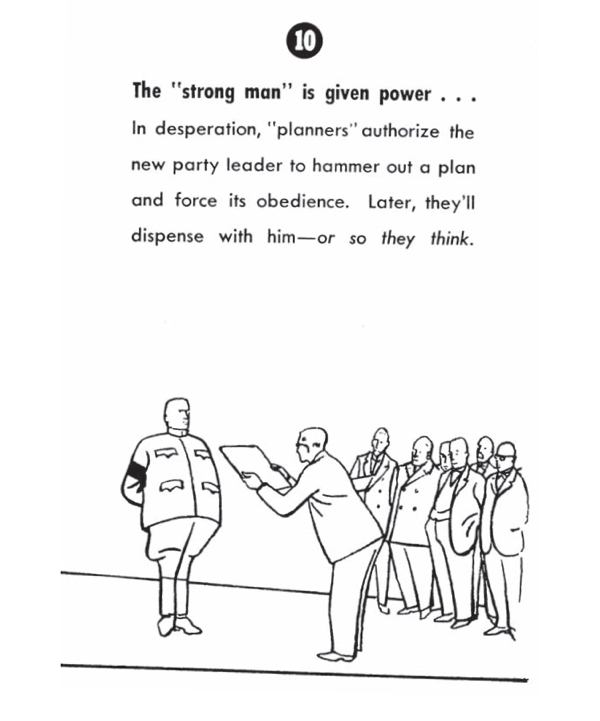

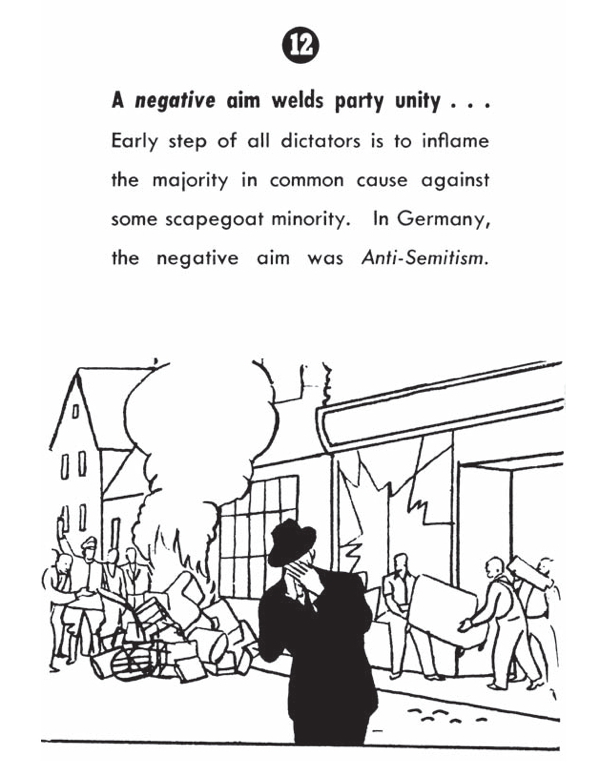

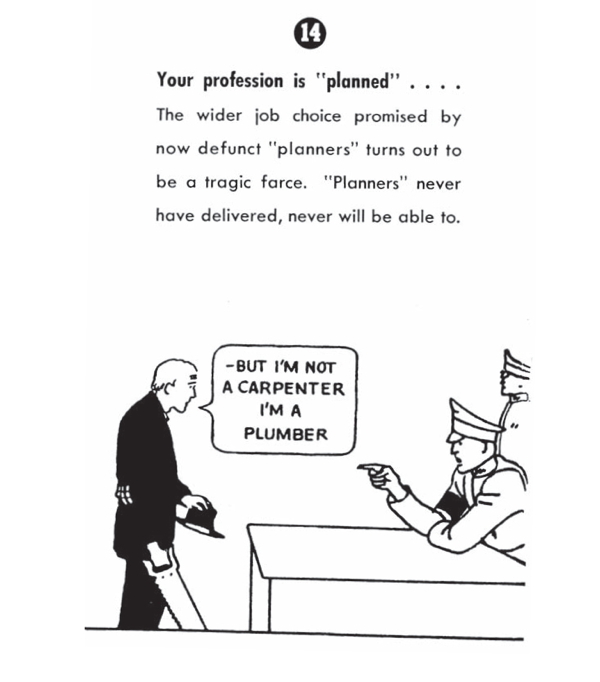
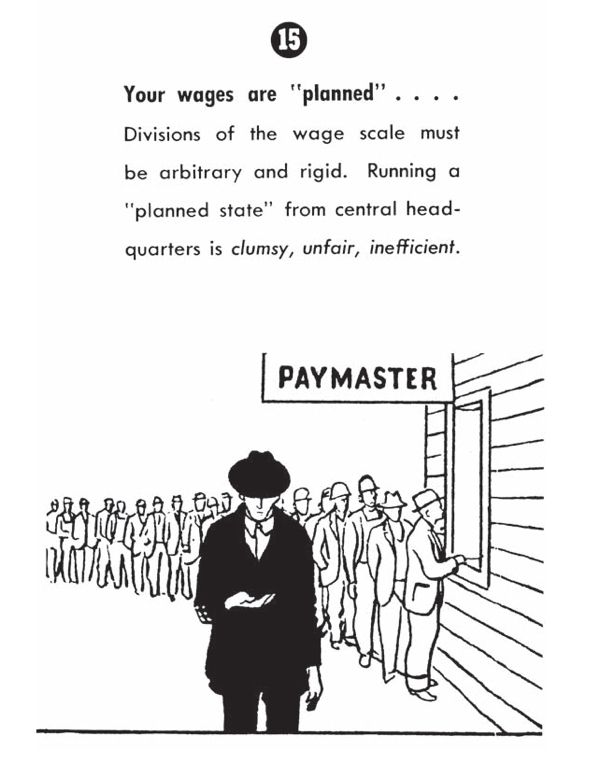


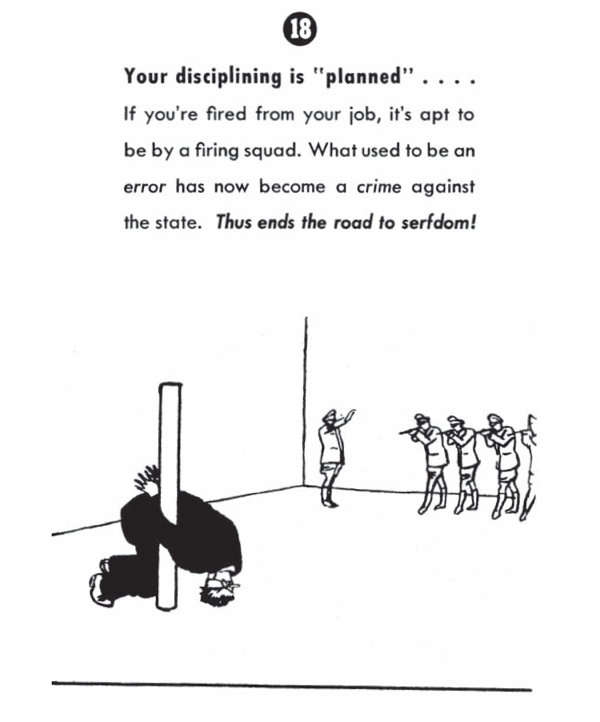

One of Frédéric Bastiat's most powerful essays is La Loi [The Law] which was published as a stand alone booklet in 1850. It was written, as was l'État [The State] (1848), as part of his reaction to the rise of socialism during the 1848 Revolution in France. In essence what Bastiat argues in these pamphlets is that forcible redistribution of tax payers money for social purposes (government unemployment relief and the right to a job in particular) is both a violation of the natural right one has to one's life and property (and thus immoral) and also impossible to achieve economically in the long term. State sanctioned plunder can work very well when a minority plunders the majority, but it is "a fiction" to believe, as many did in 1848 and 1849, that the majority can plunder the majority, which is what happens under socialism.
The French editor of the Complete Works of Bastiat, Prosper Paillottet, tells us that The Law was one of the last things written by Bastiat before he died on Christmas Eve 1850, so it is somewhat of a last will and testament. Bastiat wrote it while visiting his friends and family in his hometown of Mugron in June 1850 at a time when he must have know he was soon to die from his debilitating throat condition (perhaps cancer of the throat).
Bastiat's writings were popular for a period in Europe, being quickly translated into many European languages and they and the French editions of his works remained in print throughout the 19th century. English translations were also quickly made and Bastiat even a a "school" of followers in the late 19th century in America. Unfortunately his ideas were forgotten until the Foundation for Economic Freedom began to rehabilitate his work with new English translations in the late 1940s. The biography they had written and the new translations of the Economic Sophisms and Economic Harmonies which appeared in the mid-1960s were crucial to the revival of interest in North America in the post-war period. FEE has recently posted on their website this charming abbreviated and illustrated version of The Law [Bastiat for Dummies?] which they published in the late 1940s. It can be found here at FEE and here at my website.
FEE's edition reminds me very much of a similar abbreviated and illustrated version of Friedrich Hayek's The Road to Serfdpm (1944) which appeared at much the same time and which was obviously intended for a similar audience, namely ordinary people who had lived through the enormous expansion of government power which had taken place during the Second World War and who were new to the radical economic and political ideas of liberty which were common place in the 19th century. A condensed version of Hayek's Road to Serfdom appeared in the Reader's Digest in April 1945 and an illustrated version in Look magazine in February 1945.
See the works by Bastiat on the OLL <http://oll.libertyfund.org/person/25> including a version of The Law published by FEE <http://oll.libertyfund.org/title/78> [warning: the FEE translation has very annoying and unnecessary headings inserted by the translator which were not in the original].
We include the illustrations from the FEE edition of the late 1940s below:

[The title page]
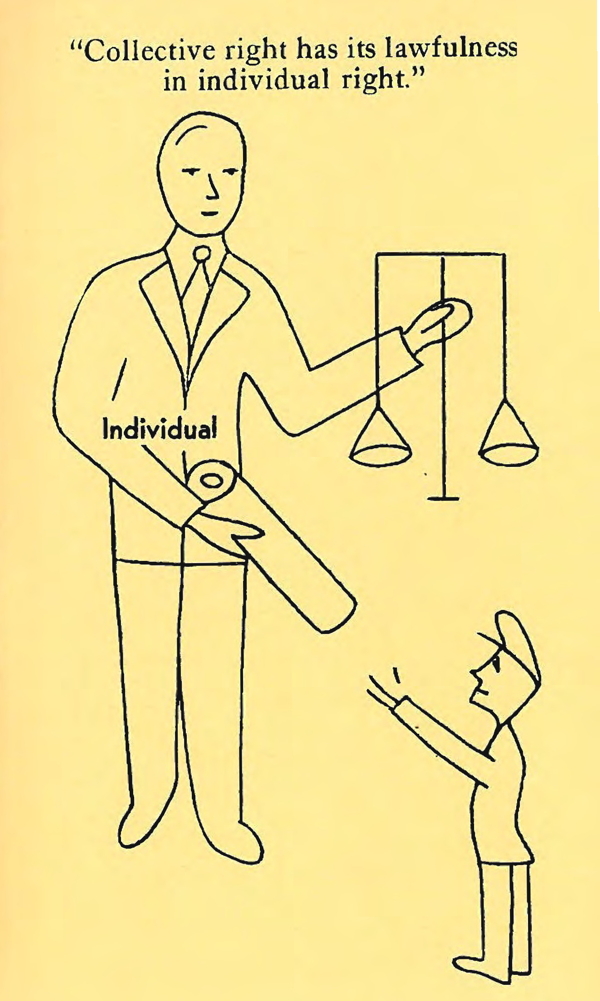
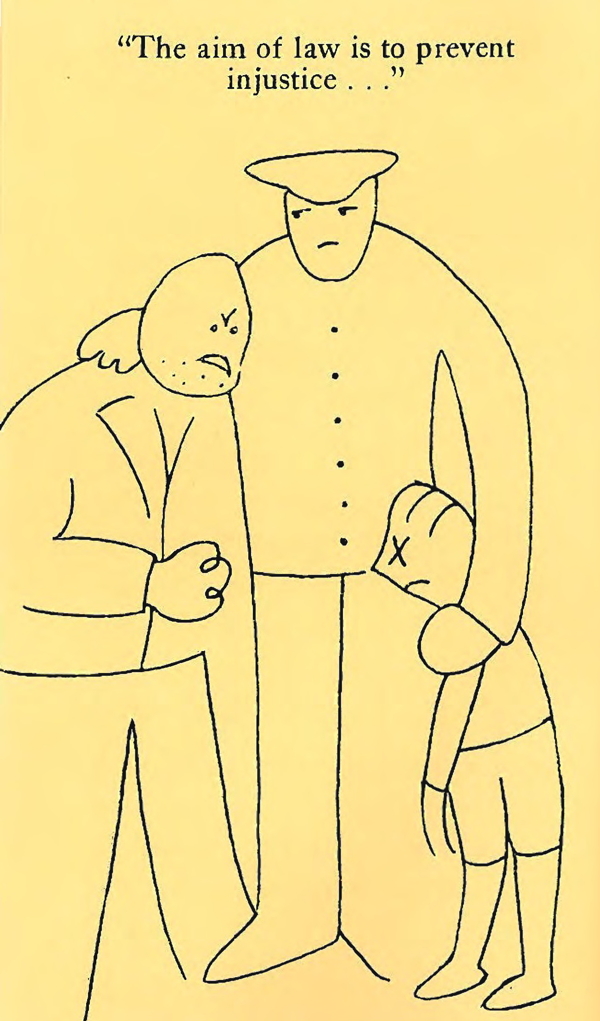
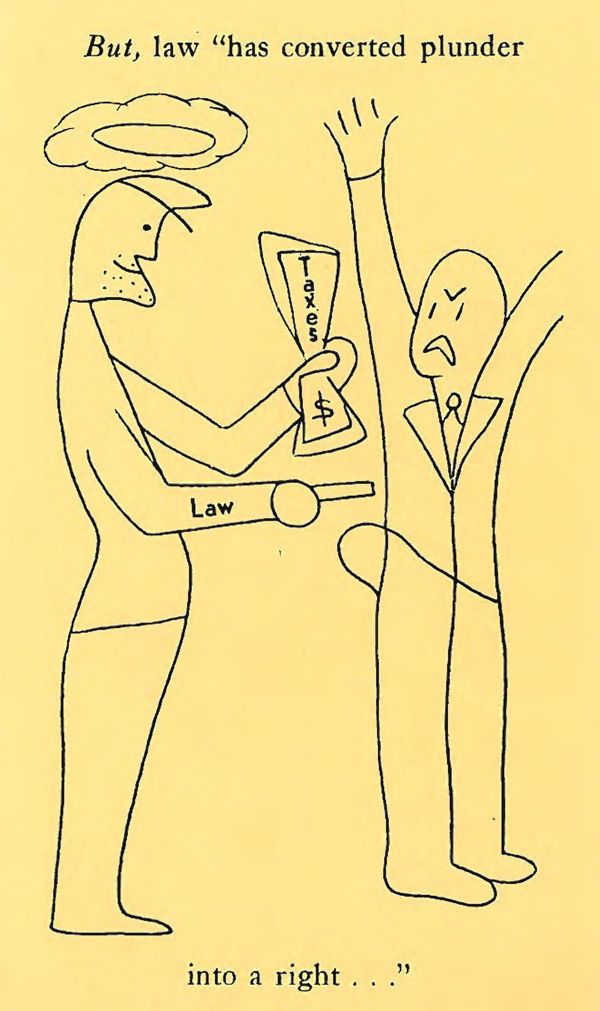
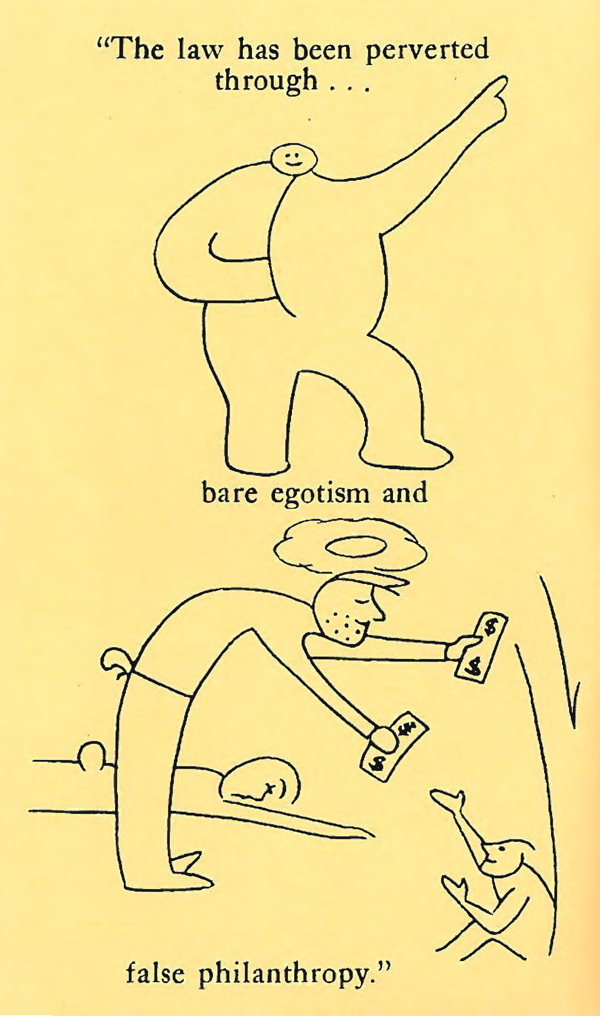
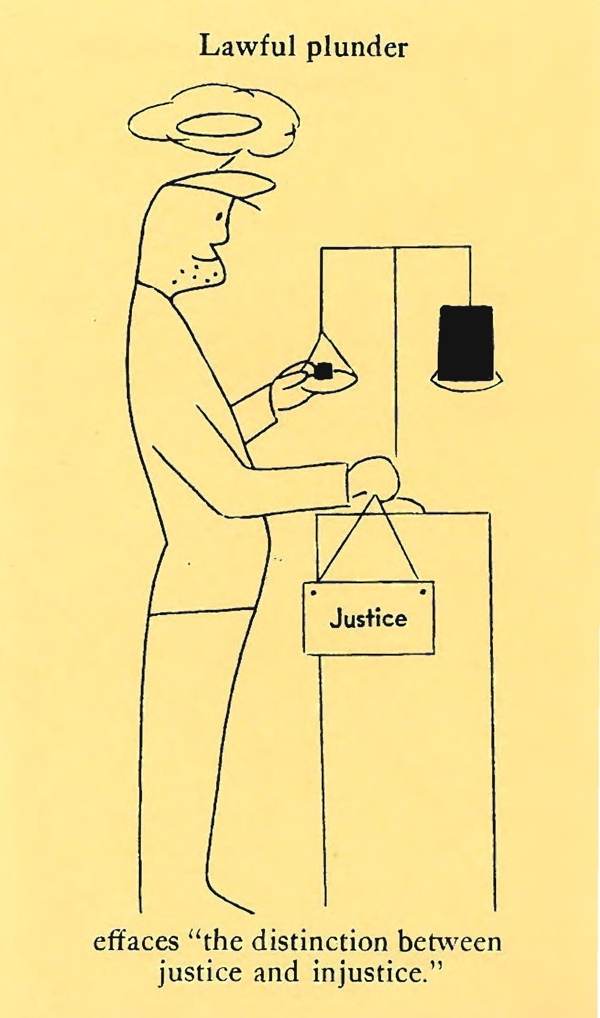
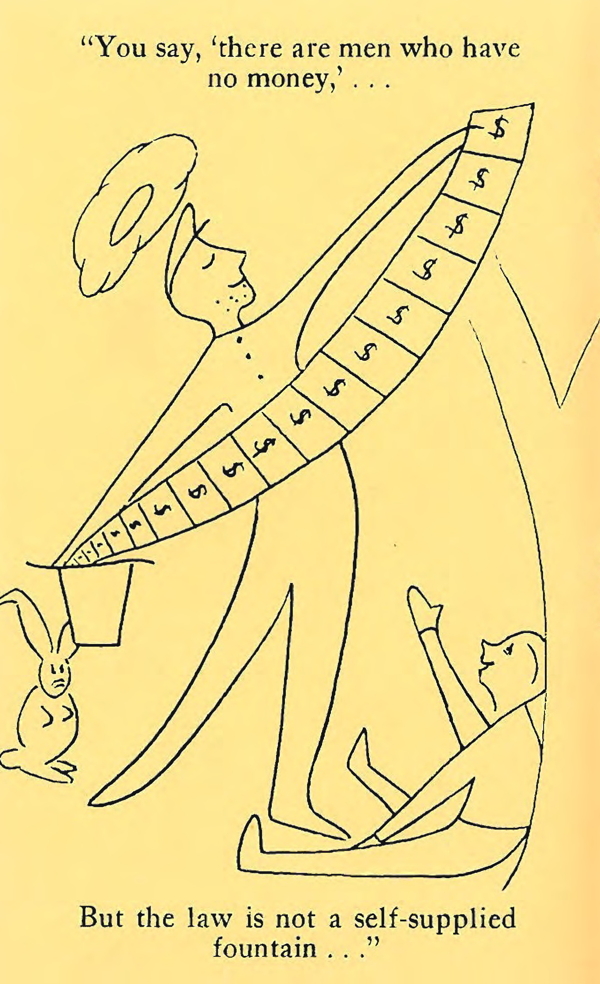

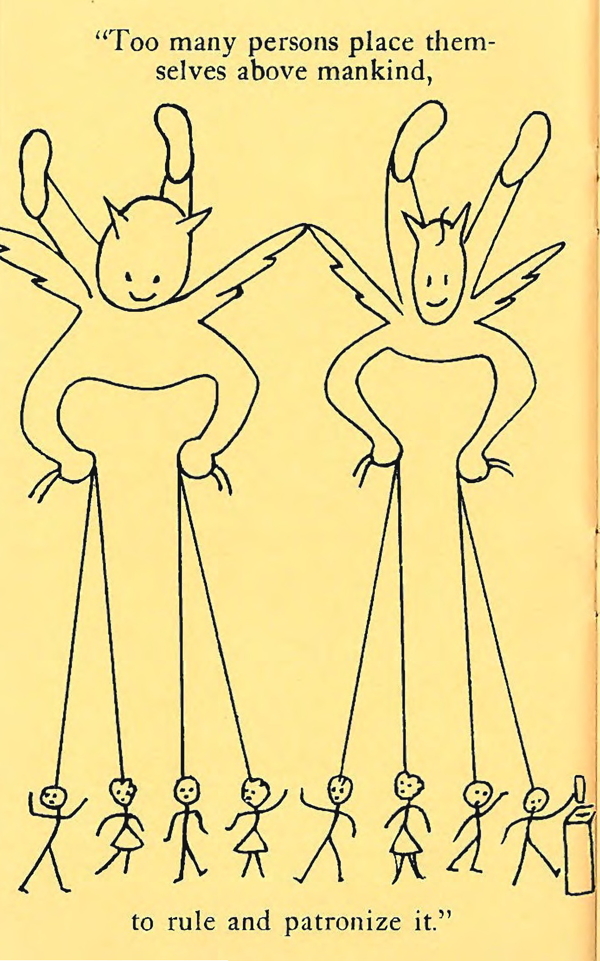


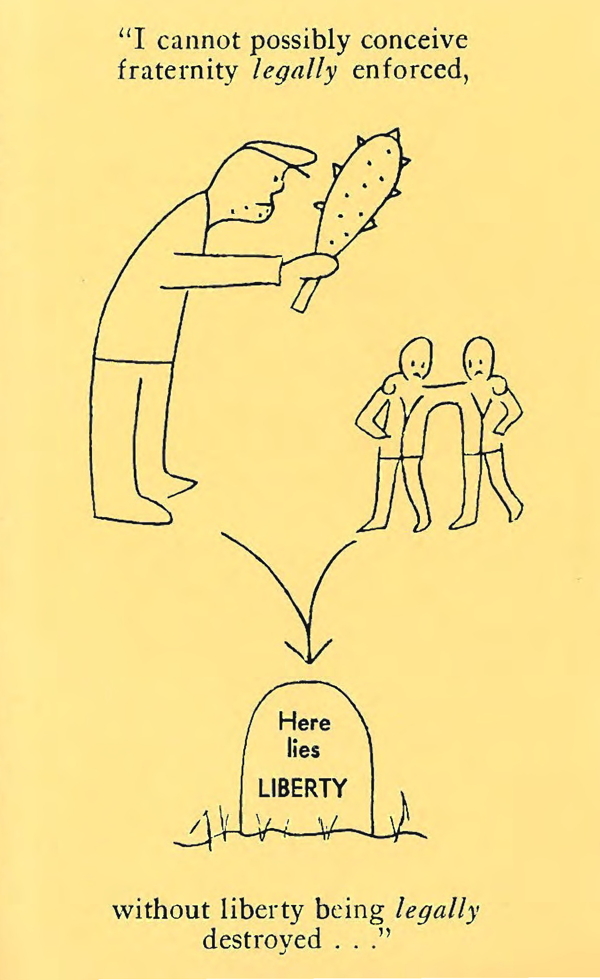
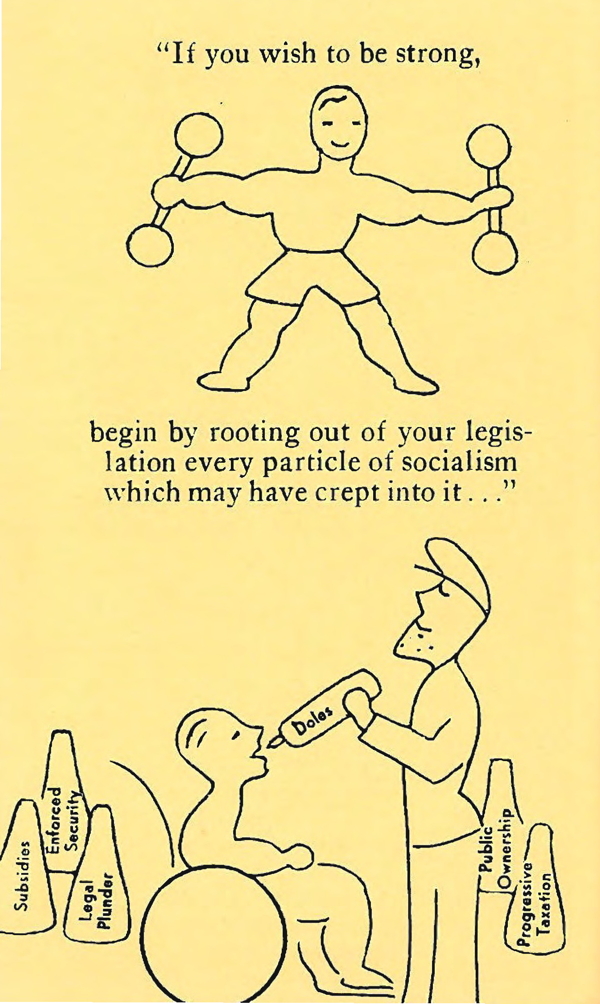
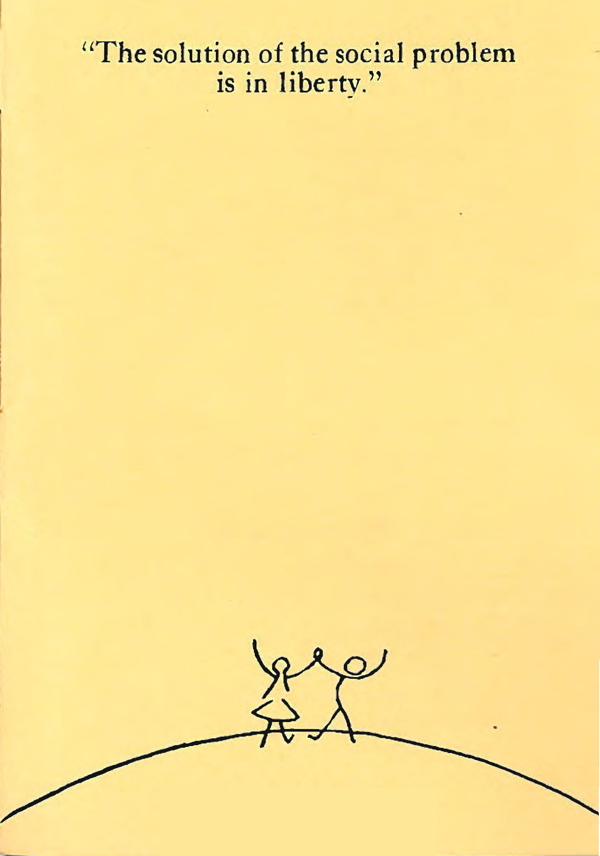

Louis Mandrin (1725-55) was a famous 18th century brigand and highwayman who challenged the privileges of the Farm General (la Ferme générale - or "Tax Farmers") by smuggling goods across the French border which were the monopoly of the Farm General.
The Farm General was reorganized in 1726 to include a group of 40 (later 90) politically well connected individuals (the Farmers General - "les Fermiers généraux) who were given exclusive contracts by the king (via the Minister of Finance who received his cut in the form of bribes, or "pots-de-vin") to sell and thereby collect taxes on such items as salt, tobacco products, wine, and to enforce compulsory work on public goods such as roads (the octrois). This was an early version of "contracting out" or "privatizing" the collection of customs and taxes and was much hated by ordinary people in the 18th century. When the Farmers General were abolished in 1971 28 of the members were arrested and executed, including the mathematician Antoine Lavoisier.
Mandrin was under contract with the Farm General to supply mules to the French army but when most of the died in transit the Farm General refused to pay him. After several run ins with the law resulting in Mandrin being condemned to death in 1753 and after his younger brother was executed for counterfeiting, Mandrin "declared war" on the Farmers General and began smuggling untaxed goods across the Swiss border and selling them in France. He became a popular hero for resisting the tax collecting Farmers General, which he did for the following 2 years before he was finally arrested and executed.
Mandrin became a folk hero about whom popular songs were written and in the 20th century even films and a TV show were made about his exploits. A local Grenoble dark beer was also named after him in 2002.
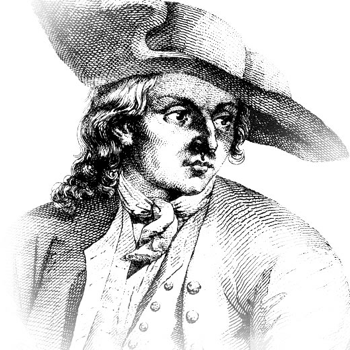
Here are some images of him from the Bibliothèque nationale and some further reading:
Begin with the Wikipedia article (in English) <http://en.wikipedia.org/wiki/Louis_Mandrin> and then the French one <http://fr.wikipedia.org/wiki/Louis_Mandrin>.
There is a Mandrin website (in French) with lots of resources <http://www.mandrin.org/>.
A film of the exploits of his followers after his execution will be appearing in early 2012 - Les Chants de Mandrin (2011), "The Ballads of Mandrin". The webiste with a trailer is here <http://www.mandrin.org/les-chants-de-mandrin.html>.
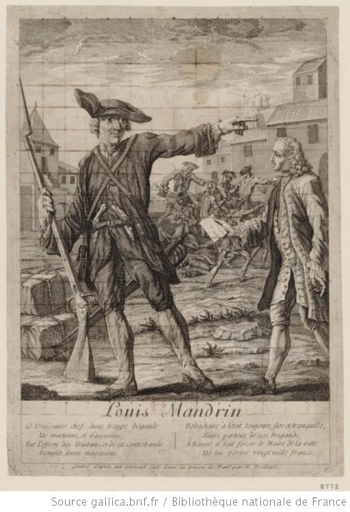
This is my favorite depiction of Mandrin. He is telling the Tax Farmer (who is showing him his official papers from the King) where to go. The goods he is "liberating" from the tax farmer so he call sell them tax free to the people are scattered on the ground.
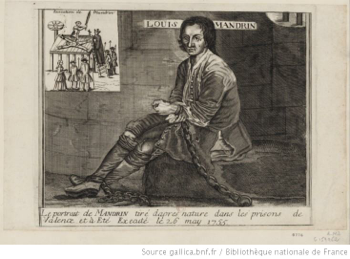
This is the saddest one with Mandrin chained in prison waiting to be beaten of the rack and slowly killed by the French Army.
Here are a selection of other depictions of him:
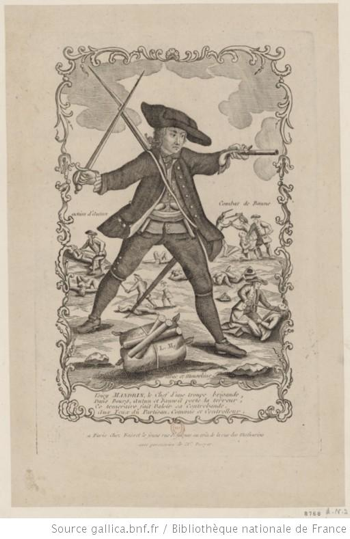
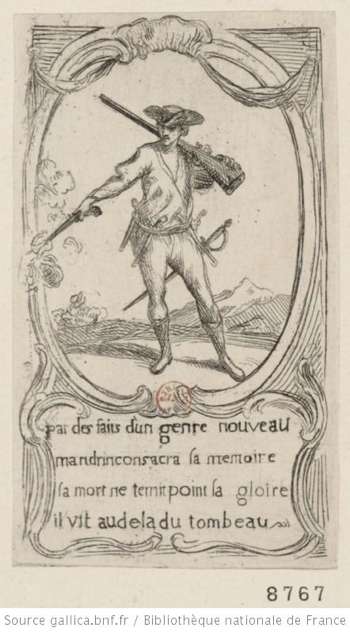

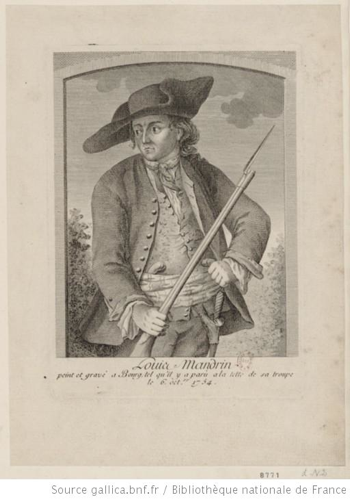
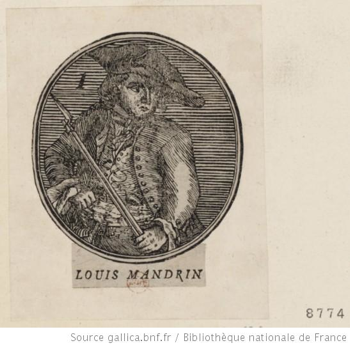
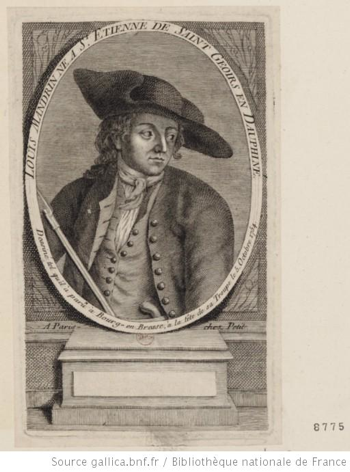
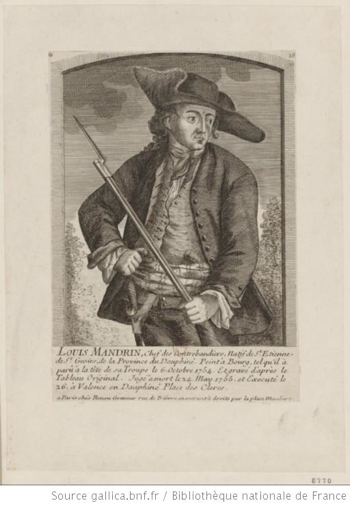
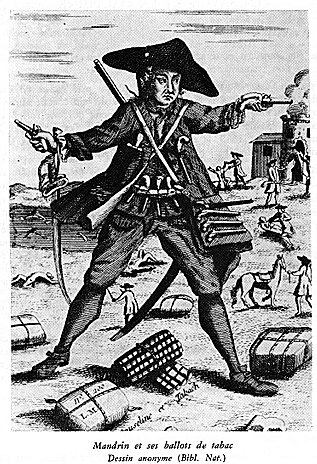
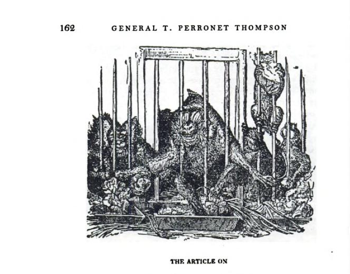
[See a larger version 740x578 px 459 KB]
Molinari saw a French translation of a British pamphlet of an article which was first published in the Westminster Review in January 1830. "The Article on Free Trade”was written by Col. Thomas Perronet Thompson who was very active in the free trade movement and whose work on the Corn Law Fallacies influenced Frédéric Bastiat. The essay was accompanied by a cartoon drawn by Thomas Landseer (1795-1880) who had made a name for himself by publishing a series of caricatures of humans as monkeys, Monkey-ana, or Men in Miniature (1827). Molinari was so taken with Landseer's drawing that he mentioned it twice: once in Les Soirées and again in his article on "Liberté du commerce”in the DEP. Thompson began his article with this description of the cartoon: "The monkeys in Exeter Change used to be confined in a row of narrow cages, each of which had a pan in the centre of its front for the tenant's food. When all the monkeys were supplied with their messes, it was observable that scarcely any one of them ate of his own pan. Each thrust his arm through the bars, and robbed his right or left hand neighbor. Half what was so seized was split and lost in the conveyance; and while one monkey was so unprofitably engaged in plundering, his own pan was exposed to similar depredation. The mingled knavery and absurdity was shockingly human.”This "beggar thy neighbor”policy is very similar to the views expressed by Huskisson in 1826 also quoted by Molinari. See, The Article on Free Trade, from the Westminister Review, no. XXIII. For January, 1830. To which is added a Collection of Objections and the Answers (London: Robert Heward, 1831); French translation of T. Perronet Thompson, Les Singes économistes, ou qu'est-ce que la liberté du commerce? extrait de la "Revue de Westminster" (The Monkey Economists, or what is free trade?), traduit de l'anglais par Benjamin Laroche (Paris: Goetschy fils, 1832).
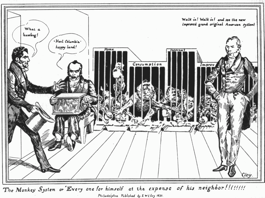
[See a larger version 1106x828 px 183KB]
A version of this cartoon also appeared in America in 1831 by E.W. Clay entitled "The Monkey System or 'Every one for himself at the expense of his neighbor'!!!!!!!!". Above the monkeys' cages is written "Home, Consumption, Internal Improvements,”and a figure states "Walk in! Walk in! and see the new improved grand original American system.” The American System as it was called was based upon high tariffs and extensive government funded infrastructure projects.
[See Part I of this essay on Searle]
Here are some other cartoons and illustrations which deal with political and military issues:
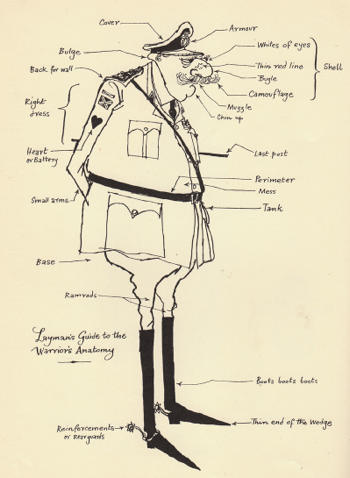
[The Anatomy of a Warrior] [See a larger version of this image]
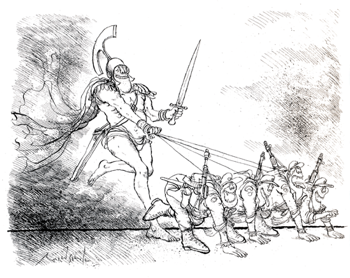
["Mercenaries"] [See a larger version of this image]
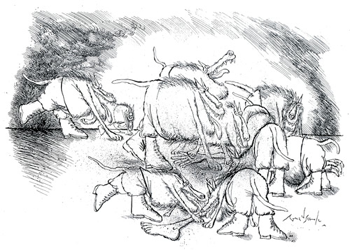
[Ethnic Cleansing] [See a larger version of this image]
The image below is very much in the style of Honoré Daumier's bitter cartoons of the German Wars of Unification during the 1860s, especially "Peace Idyll".
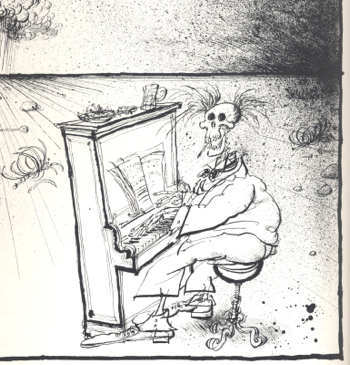
[After the Atomic Apocalypse] [See a larger version of this image]
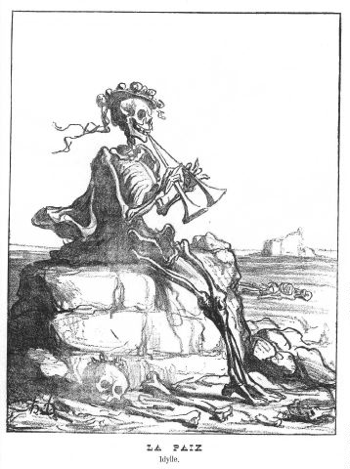
[Daumier, "Peace Idyll"]
Here are some miscellaneous pictures which I found interesting and/or amusing:
[A drawing of a deer in the style of Picasso's horse in Guernica]

[Wounded Horse from Picasso's "Guernica" (1937)]

[London: Revolt in Trafalgar Square, 1964] [See a larger version of this image]
The image below is the reverse of the Scandinavian idea of the Yule Goat which takes from the children at Christmas. Here the children hijack Santa and seize the toys themselves. See this post.
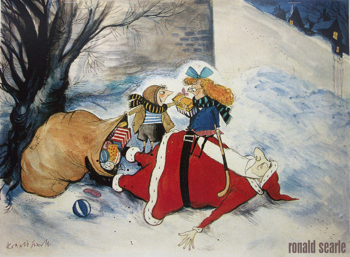
[Robbing Santa: "This one is for you, this one for me"] [See a larger version of this image]
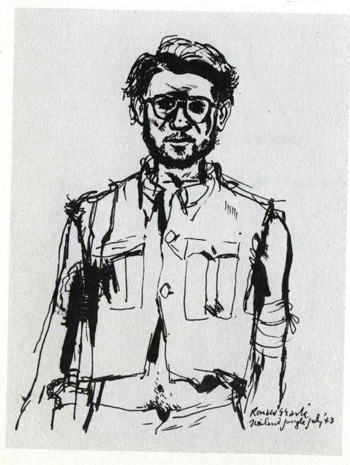
[Self Portrait in Thai Jungle July 1943]
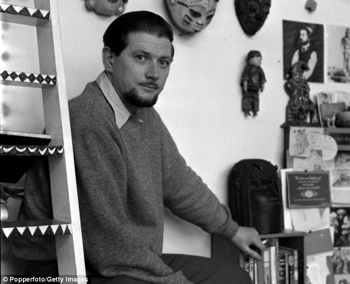
[Searle in 1954]
The English cartoonist and illustrator Ronald Searle died on 31 December 2011. He is unfortunately best remembered for his drawings about the fictional British public school for girls "St. Trinians" which he conceived while a captive of the Japanese during WW2. He regretted the fame and typecasting which came from this early success and moved to Paris then the south of France in order to concentrate on his book illustrations and cartoons. Many of the following illustrations come from the collection in the Imperial War Museum or Perpetua - Ronald Searle Tribute <http://ronaldsearle.blogspot.com/>

[Victory on the Hockey Field] [See a larger version of this image]
I came across the other side of his work when I read his book To the Kwai - and Back: War Drawings, 1939-1945 (Collins and Imperial War Museum, 1986) when I was researching the art which emerged from the POW and concentration camps of WW2. His collection of eyewitness drawings of life in Changi Prison in Singapore and the work camps of the notorious Thai-Burma railway is extraordinary. He secretly documented his experiences and hid them from his guards by placing them under the mattresses of soldiers who were dying from cholera. The brutality and disregard for human life which he experienced first hand led him to ask himself the question - "could this happen to people in my home country, or is this something peculiar to the Japanese people and their culture?" His answer seems to be that it is a universal phenomenon.
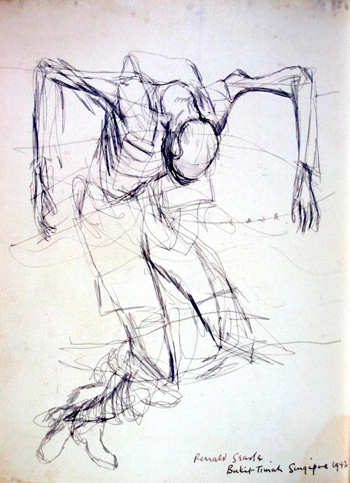
[Dead man on barbed wire fence, Singapore 1942] [See a larger version of this image]
His stroke of genius was to imagine a typical English private school for girls where the girls behaved in a violent manner towards their peers and their teachers. Behind the apparently humorous hijinks of the girls was a darker view of human nature in which violence, torture, and moral collapse was the order of the day. Searle did his first cartoons of the girls of St. Trinians while he was a prisoner and sold them to magazines upon his return to civilian life. They subsequently appeared in books and then as films and made him a fortune.
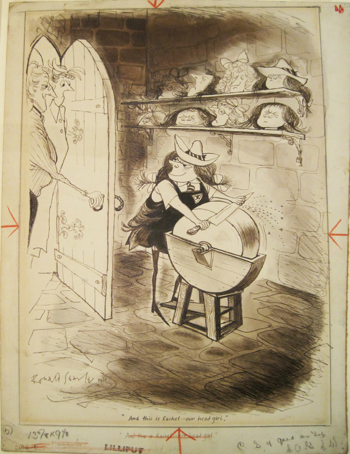
[The "Head Girl" Rachel] [See a larger version of this image]
After his move to Paris in 1961 Searle was very successful with his work on magazine covers, cartoons, book illustrations and other art work. I have selected a number of works which illustrate his interest in the military and the political events of his day. He explicitly acknowledged the influence of people like Francisco Goya, Honoré Daumier, George Grosz, and Pablo Picasso, all of who were also "political" in one way or another.
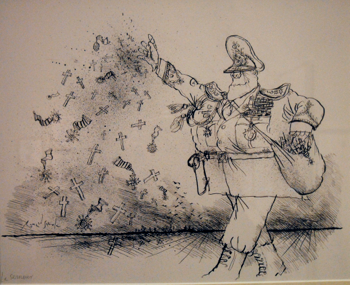
[A cartoon from Le Monde - "The Sower"] [See a larger version of this image]
The following pictures come from "To the Kwai and Back":
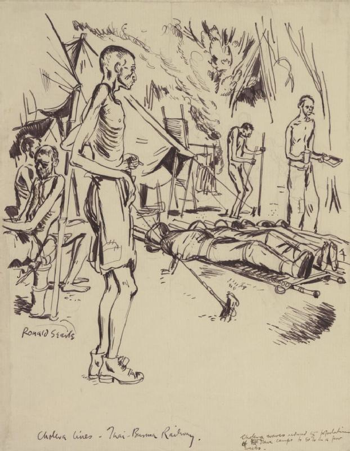
["Cholera Lines" 1943] [See a larger version of this image]
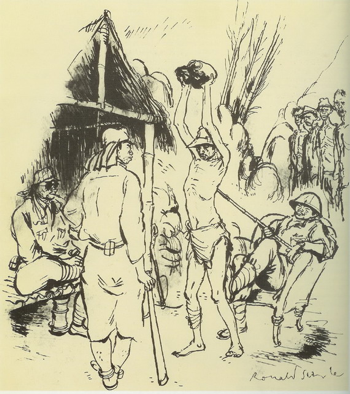
[Torturing prisoners for Fun at Lunch Time 1943] [See a larger version of this image]

[Prisoners were forced to sign an oath of obedience] [See a larger version of this image]
Here are some more images about St. Trinians girl school. A "battle cry" was written for the girls which goes as follows:
Maidens of St Trinian's, gird your armour on.
Grab the nearest weapon; never
mind which one.
The battle's to the strongest; might is always right.
Trample on the weakest;
glory in their plight.
St Trinian's! St Trinian's! Our battle cry.
St Trinian's! St Trinian's! Will
never die.
Stride towards your fortune boldly on your way,
Never once forgetting there's
one born every day.
Let our motto be broadcast: "get your blow in first!"
She who draws
the sword last always comes off worst.
The large drawing below of "The Fall of St. Trinians" is a veritable battle painting in the style of the 17th century French engraver Jacques Callot who meticulously documented the battles and guerrilla fighting of the Thirty Years War, such as "The Siege of Breda".
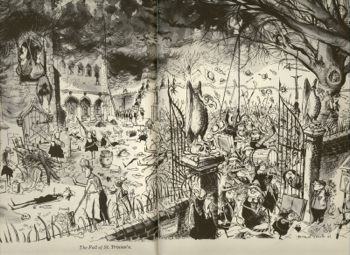
[The Fall of St. Trinians] [See a larger version of this image]
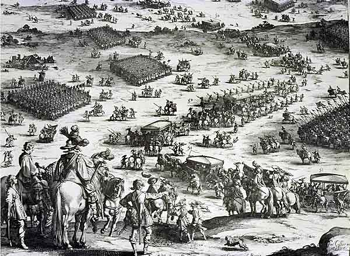
[Detail from Jacques Callot, "The Siege of Breda" (1628)] [See a larger version of this image]
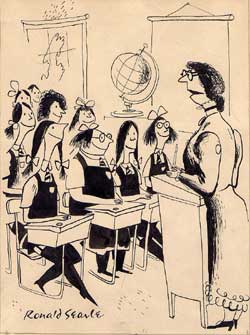
[The teacher asks the girls who set fire to the East Wing, 1944]
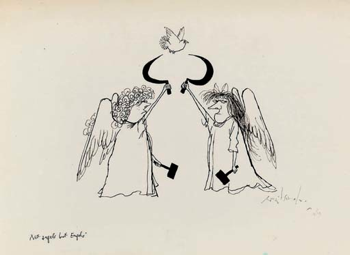
["Not Angles but Engels"] [See a larger version of this image]
Robert Graves wrote a "School Hymn for St. Trinians" which was illustrated by Searle:

[See a larger version of this image]
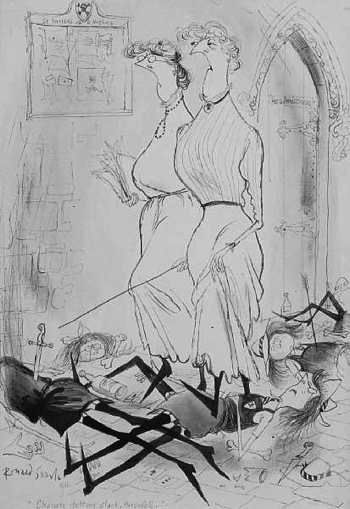
[Teachers complaining about the failure of the cleaners to keep the corridors clean] [See a larger version of this image]
[See Part II for further discussion]
In early December I was able to go to the Art Gallery of NSW to see the Picasso exhibit which consisted of 150 odd pictures and sculptures lent by the Picasso Museum in Paris. I was excited to see for the first time two pictures which I had never seen in the flesh before - "Minotauromachy" (1935) and "Massacre in Korea" (1951). [See my study guide on Picasso's war art for more info].
The "Minotauromachy" (1935) has many references to classical mythology and prefigures some of the imagery which we see a couple of years later in "Guernica" (1937): the bull, the injured horse, the girl/woman with the lamp, people in a window surveying the scene, etc.

[See larger image]
Compare with this compositional study for "Guernica"(1 May, 1937):
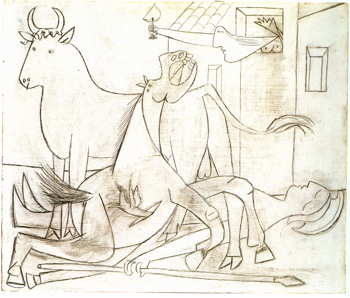
[See a larger image]
The "Massacre in Korea" (1951) has robotic, futuristic soldiers lined up to shoot innocent women and children.
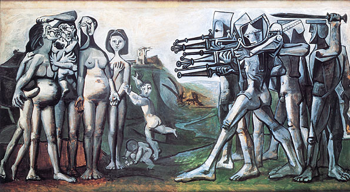
[See a larger image]
Picasso's debt to Francisco Goya's "Third of May", where invading French soldiers round up and execute citizens of Madrid after they rose up in opposition to the occupation of their city, is clear. [See my study guide on Goya for more info]
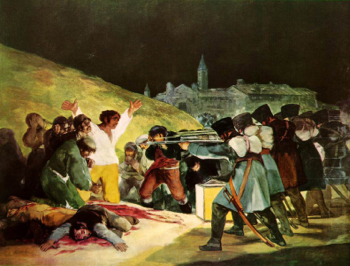
[See a larger image]

On November 18 a group of peaceful student demonstrators at the University of California, Davis were pepper sprayed by a campus policeman. A photograph of the event went viral on the internet. There are a number of interesting aspects of this horrifying event: the nonchalance and arrogance of the cop who is methodically spraying pepper into the faces of the seated, unresisting students; the reaction of the university administration; and the way in with the now iconic image of the cop was used in combination with great works of art to make a political point. Here is a sampling of the art which was "violated" by the "pepper spray cop" as he violated the rights of the unresisting students. Many of the "rewordings" of the paintings (and a film) are overtly political, especially those by Delacroix, Picasso, Trumbull, Sargent, and Kubrick. How little could the brutal cop have imagined the political and artistic creativity his action would trigger:
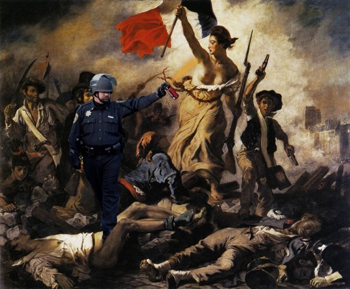
[Delacroix's "Liberty leading the People" (1830)]
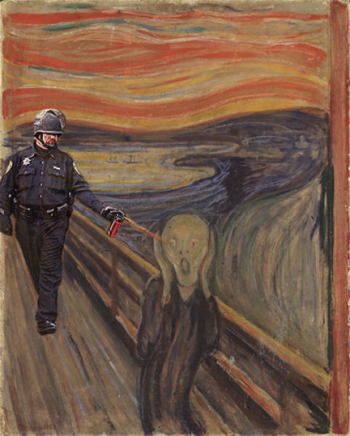
[Edvard Munch, "The Scream" (1893)]

[Picasso's "Guernica" (1937)]

[I couldn't identify the painting but it looks like something by Jackson Pollock]
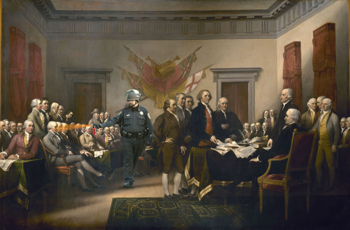
[John Trumbull's "Declaration of Independence" (1819)]

[John Singer Sargent, "Gassed" (1918-1919)]
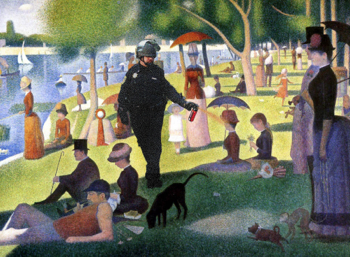
[Seurat's "Sunday Afternoon on the Island of La Grande Jatte" (1884–1886)]

[The "Pepper Spray Cop" is now one of the droogs in Kubrick's film "A Clockwork Orange" (1971)]
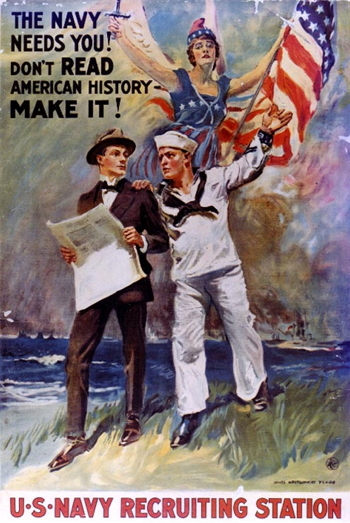
[See a larger version]
When reading Michael Kammen, In the Past Lane: Historical Perspectives on American Culture (OUP, 1999) I came across this piece of war propaganda by James Montgomery Flagg, "The Navy Needs You" (1917). The unintended irony of the image is that if one did read history one might be less inclined to "make history" by going off to fight in an unnecessary or unjust war.
The gloriously named "James Montgomery Flagg" did several dozen propaganda posters for the US government during WW1. Flagg is best known for his "Uncle Sam Needs You" recruiting poster.
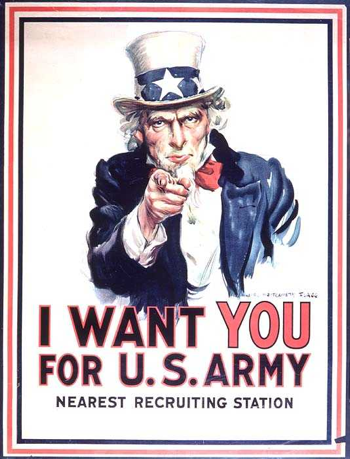
[See a larger version]
If you were a novelist and you gave the name "Flagg" to a super patriot people would laugh at you. This was also the name given to the super patriotic CIA officer in the TV series M*A*S*H and viewers quite rightly laughed at his stupidities.
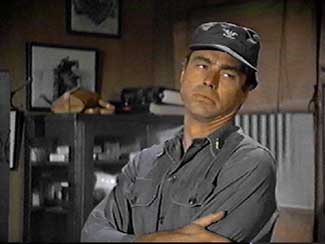
Another of my favorites is Flagg's "Side by Side - Britannia" (1918) in which he links British and American imperialism - Uncle Sam and Britannia have linked their arms together and the American eagle and the British lion are on guard against the enemies of empire:

[See a discussion of the politics of animal imagery] [See a larger version]